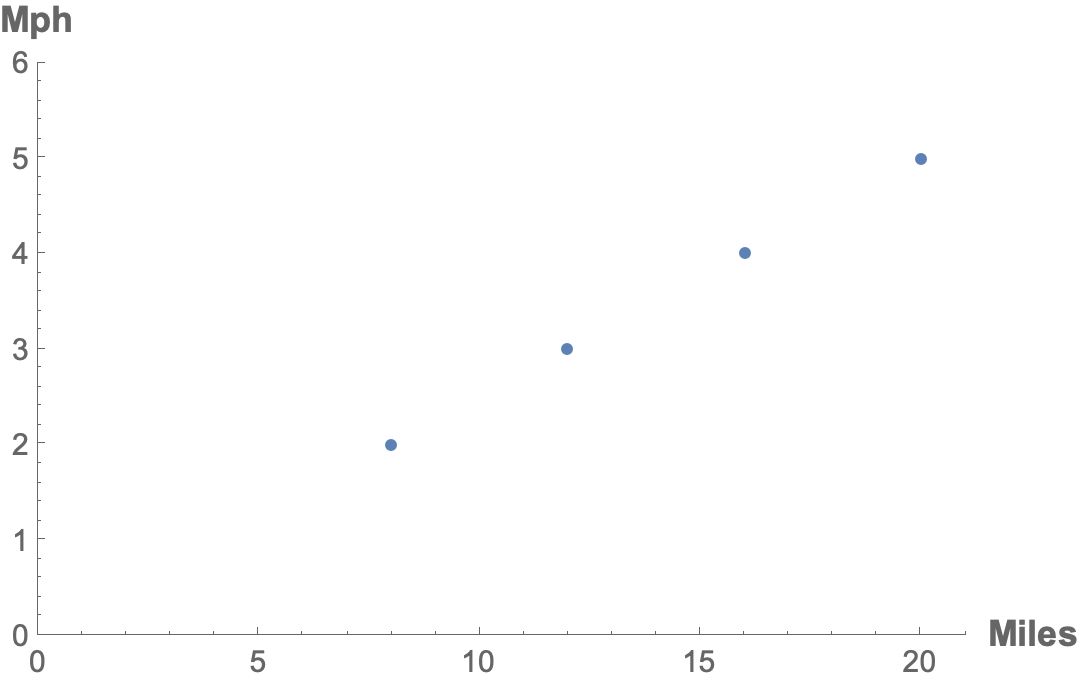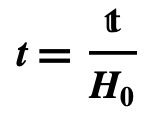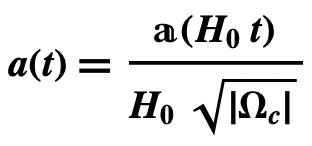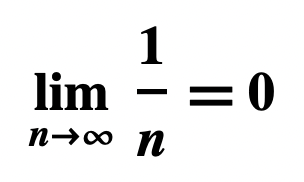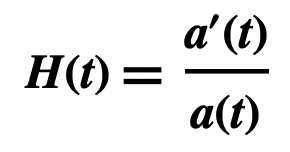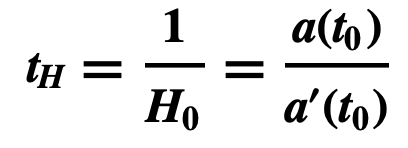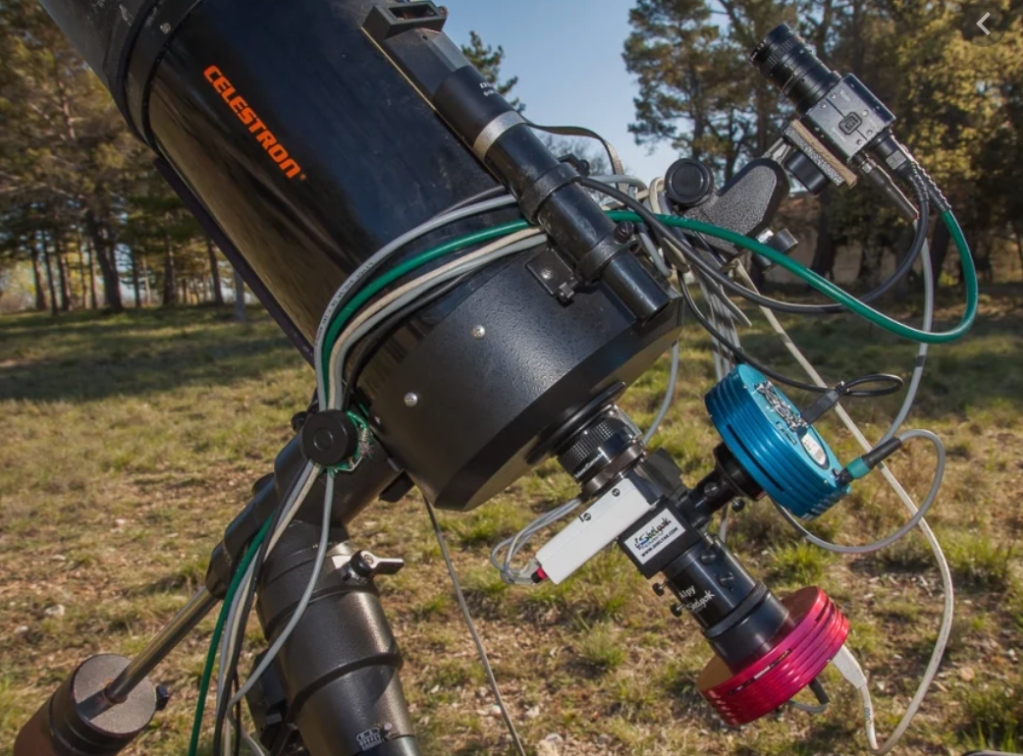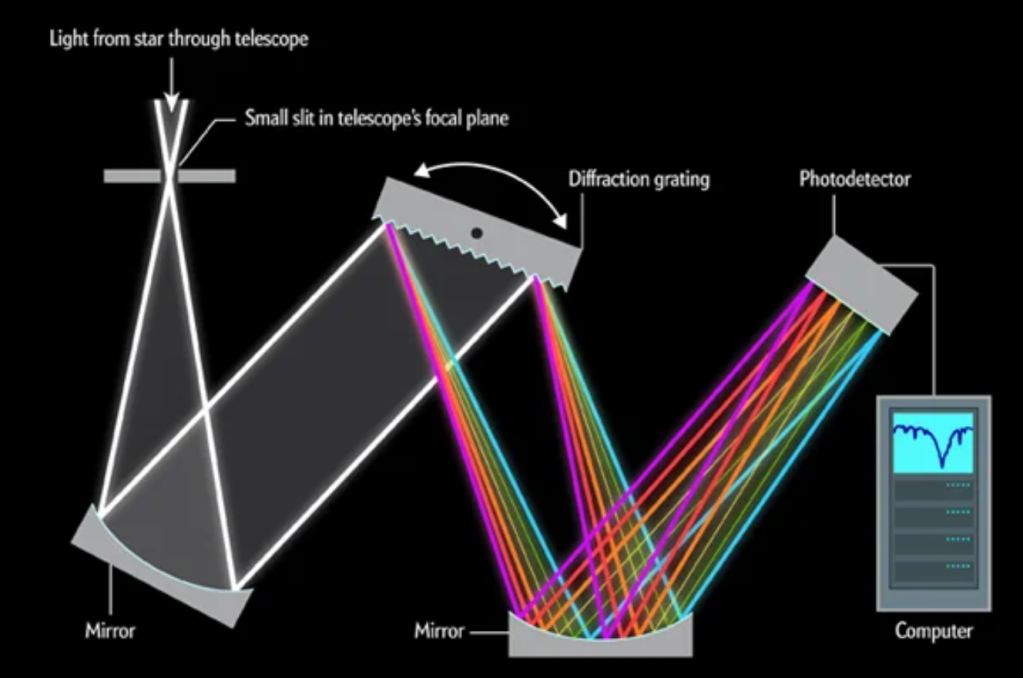Back to Scientific Theories
Table of Contents
- Core Idea
- Three Pieces of the Big Bang Theory, Color-coded
- Overview of the Theory
- Development of the Pieces
- Expansion of Space and Recession of Galaxies
- Particle History and CMB Radiation and Light Elements
- Dark Matter
- Dark Energy
- Age and Fate of the Universe
- Friedmann Equation, Rescaled Omega Version
- An Analogy
- Density
- Different Amounts of Stuff
- Almost No Stuff
- Enough Matter and Radiation to Reverse the Expansion
- Minimal Matter and Radiation to Keep the Universe Expanding
- Different Kinds of Stuff
- Matter Dominated Universe
- Radiation Dominated Universe
- Dark Energy Dominated Universe
- Age and Fate of the Universe, Consensus View
- Matter-Energy History of the Universe
- Resources
- Addenda
Core Idea
Space has expanded and the universe cooled from a singularity of infinite density and temperature 12 to 14 billion years ago.
(The age of the solar system is 4.5 billion years.)
Three Pieces of the Big Bang Theory, Color-coded
General Relativity Applied to the Universe as a Whole
Cosmological Observations of the 20th Century
Particle Physics Applied to the Early Universe
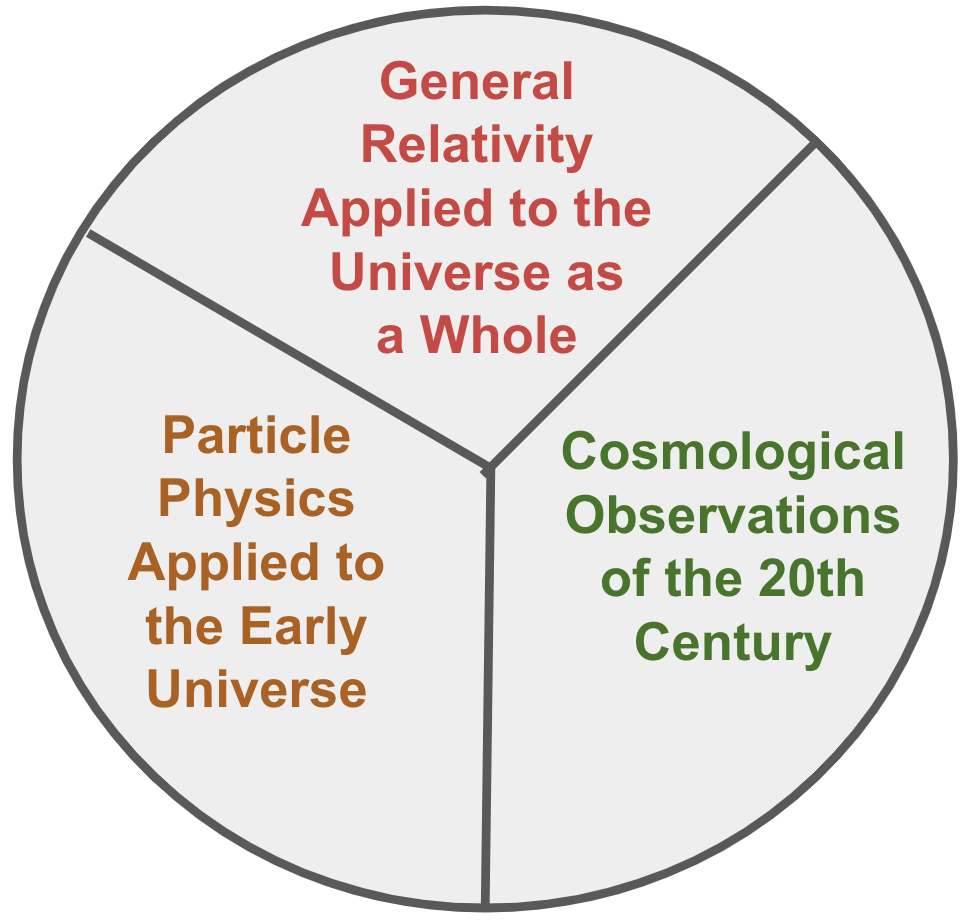
Overview of the Theory
- A scientific theory is:
- designed to explain certain kinds of phenomena
- defined by its postulates
- supported or disproved by its predictions
- For example, Newton’s Theory of Gravitation is:
- designed to explain:
- the motion of falling bodies
- the orbits of heavenly bodies
- defined by its postulates
- Law of Universal Gravitation
- Equation of Motion
- supported by its predictions of
- Kepler’s Laws of Planetary Motion
- Galileo’s Laws of Falling Bodies and Projectile Motion
- designed to explain:
- The Big Bang Theory is
- designed to explain:
- the implications of Einstein’s General Relativity for the universe as a whole
- why galaxies beyond the Milky Way are moving directly away from us, at speeds correlated with their distance.
- what particle interactions took place in the first few seconds and minutes after the Big Bang
- defined by its postulates:
- Expansion of Space
- Based on General Relativity, Einstein’s theory that gravity is the curvature of spacetime.
- Particle History of the Early Universe
- Based on the Standard Model of Particle History, the theory governing the electromagnetic, strong, and weak interactions of elementary particles and fields.
- Expansion of Space
- supported by its predictions of:
- Recession of Galaxies
- Cosmic Microwave Background Radiation
- Abundance of Light Elements
- designed to explain:

Development of the Pieces
- 1915 General Relativity
- Einstein set forth General Relativity, his theory that gravity is the curvature of spacetime.
- The theory’s postulates have been famously summarized by John Archibald Wheeler:
- “Matter tells spacetime how to curve, and curved spacetime tells matter how to move.”
- View Space, Time, and Spacetime
- The theory is supported by incredible predictions such as:
- Space expands and contracts.
- Gravitational waves, detected in 2015, are waves of expanding and contracting space.
- Time runs slower in gravitational fields.
- Time runs faster on the atomic clocks on board GPS satellites than it does on atomic clocks on Earth.
- More on General Relativity
- Space expands and contracts.
- 1917 Einstein’s Cosmological Model
- Einstein applied General Relativity to the universe as a whole, making two assumptions
- Cosmological Principle
- The universe looks the same on a large scale no matter where in the universe you are (homogeneity) and no matter in what direction you look (isotropy).
- Universe is static, neither expanding nor contracting.
- Cosmological Principle
- To make the universe static, Einstein added a term to the Field Equation of General Relativity: the cosmological constant
 (Lamda), representing a repulsive energy that balanced the attractive force of gravity.
(Lamda), representing a repulsive energy that balanced the attractive force of gravity.
- Britannica: Cosmological constant
- “The cosmological constant is a term Albert Einstein reluctantly added by to his equations of general relativity to obtain a solution that described a static universe, as he believed it to be at the time. The constant has the effect of a repulsive force acting against the gravitational attraction of matter. When Einstein heard of the evidence that the universe is expanding, he called the cosmological constant the “biggest blunder” of his life. However, recent observations have detected a repulsive force, similar to the cosmological constant, that is called dark energy and is the dominant component of the universe.”
- Einstein applied General Relativity to the universe as a whole, making two assumptions
- 1922 Friedmann Equation
- Alexander Friedmann published an equation, based on General Relativity, that is still today the theoretical basis of the expansion of space. Like Einstein, Friedmann assumed the Cosmological Principle. Unlike Einstein, he did not force the universe to be static.
- Alexander Friedmann published an equation, based on General Relativity, that is still today the theoretical basis of the expansion of space. Like Einstein, Friedmann assumed the Cosmological Principle. Unlike Einstein, he did not force the universe to be static.
- 1912-1929 Recession of Galaxies
- American astronomers Vesto Slipher and William Wallace Campbell observed the redshift of distant galaxies, indicating they were receding from us.
- In 1929 Edwin Hubble proposed the Hubble Law:
- The further away a galaxy is, the faster it recedes
- 1936-present FRW Cosmological Models
- Howard P. Robertson and Arthur G. Walker expanded the Friedmann Equation into a spacetime metric (the Robertson-Walker Metric), a formula that defines the geometry of spacetime on a large scale.
- Since then Friedmann-Robertson-Walker (FRW) Cosmological Models have become increasingly sophisticated, incorporating dark matter and dark energy.
- 1948 Particle History of the Universe
- George Gamow, Ralph Alpher, and Robert Herman extended the Big Bang Theory to atoms and subatomic particles, setting forth a particle history of the early universe as it cooled and expanded.
- 1948 CMB Radiation Predicted
- Ralph Alpher and Robert Herman predicted that, due to the expansion of space, electromagnetic radiation from the early universe would today be in the microwave range, permeating the universe.
- 1964 CMB Radiation Detected
- Arno Penzias and Robert Wilson shared the Nobel Prize in Physics for detecting the Cosmic Microwave Background Radiation, the radiation Alpher and Herman had predicted.
- 1970s Dark Matter
- Cosmologists recognized that the observed stellar mass of a galaxy does not exert enough gravitational force to keep it together, suggesting the existence of invisible, dark matter.
- 1998 Dark Energy
- Saul Perlmutter, Brian P. Schmidt, and Adam G. Riess shared the Nobel Prize in Physics for leading teams that independently found that the expansion of the universe was accelerating, suggesting the existence of anti-gravitational dark energy.
Expansion of Space
and
Recession of Galaxies
Recession of Galaxies
- American astronomers Vesto Slipher and William Wallace Campbell observed the redshift of distant galaxies, indicating they were receding from the Milky Way Galaxy.
- Galactic redshifts and blueshifts are shifts of lines in the electromagnetic spectrum of a galaxy. Shifts toward red indicate a longer wavelength; those toward blue a shorter wavelength.
- In the diagram, the spectral line under the tip of the arrow head moves to the right from laboratory reference (at the bottom) to very distant galaxy (at the top), resulting in an increase of wavelength from about 440 nm to almost 600 nm.
- A nanometer (nm) is a billionth of a meter.
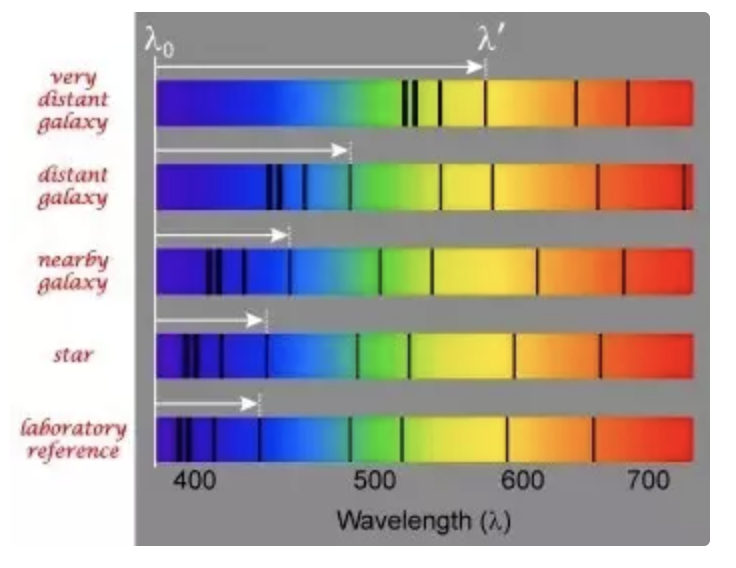
Image Credit quora.com/Astronomers-measure-the-speed-of-galaxies-using-red-shift-but-what-if-space-is-tinted-red
- Spectral shifts commonly result from the Doppler Effect, the change in the length of a wave as it’s emitted or received by a moving object. Thus a galaxy’s redshift indicates it is moving away from us. A galaxy’s blueshift means it’s heading in our direction. The larger the shift, the greater the speed.
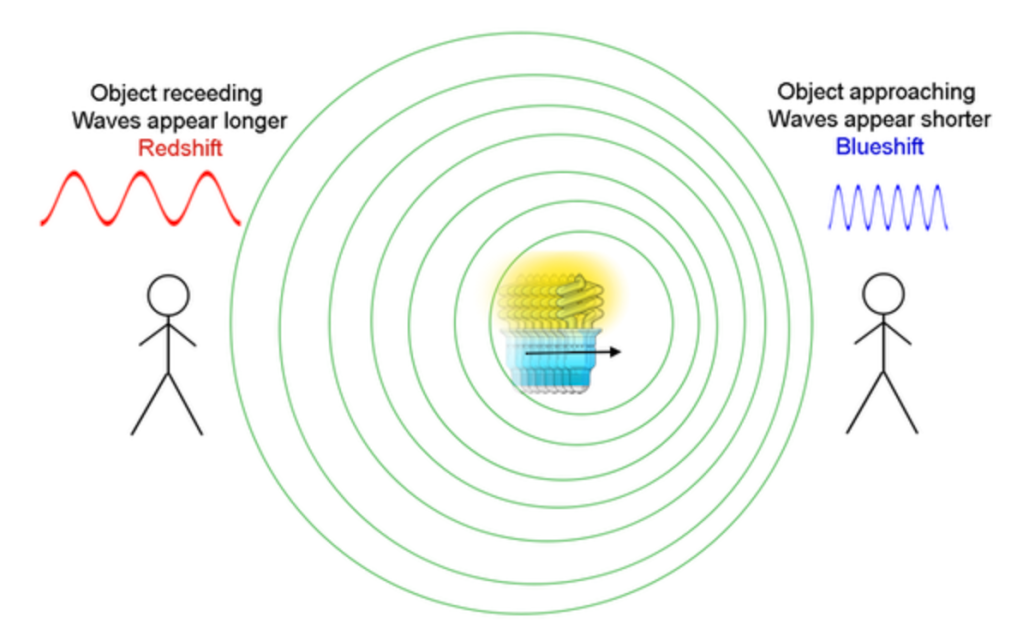
Image Credit imagine.gsfc.nasa.gov/features/yba/M31_velocity/spectrum/doppler_more.html
- Spectrographs
- View Spectrograph
- A Passing Train
Hubble Law
- Vesto Slipher and other astronomers had established that distant galaxies are receding, based on their redshift. In 1929 Edwin Hubble correlated their recessional velocities with their distance: the further away the galaxy, the faster it receded — by the same factor.
- The Hubble Law is the mathematical expression of this idea:
- v = H0 x D, where
- v is the galaxy’s recessional velocity in kilometers per second
- Based on the galaxy’s redshift
- D is the distance of the galaxy in megaparsecs
- 1 megaparsec (Mpc) = 1 million parsecs = 3,262,000 lightyears
- In 1912 Henrietta Swan Leavitt discovered that a certain class of stars, the Cepheid Variables, fluctuate periodically in their brightness and that the periodicity is correlated with their actual luminosity. Hubble used the latter to determine the distance to many Cepheid Variables and thus to the galaxies where they lived.
- H0 is the Hubble Constant, about 72 km/s per 1 megaparsec (Mpc)
- 72 km/s = 161,059 mph
- v is the galaxy’s recessional velocity in kilometers per second
- v = H0 x D, where
- Thus a galaxy 4 Mpc distant moves away at 288 km/s (72 x 4 = 288). A galaxy 2,500 Mpc from us recedes at 180,000 km/s (72 x 2500 = 180,000).
- A graph of recessional velocity (km/s) against distance (Mpc) shows galaxies straddling the Hubble Constant diagonal at 72 km/s per Mpc.
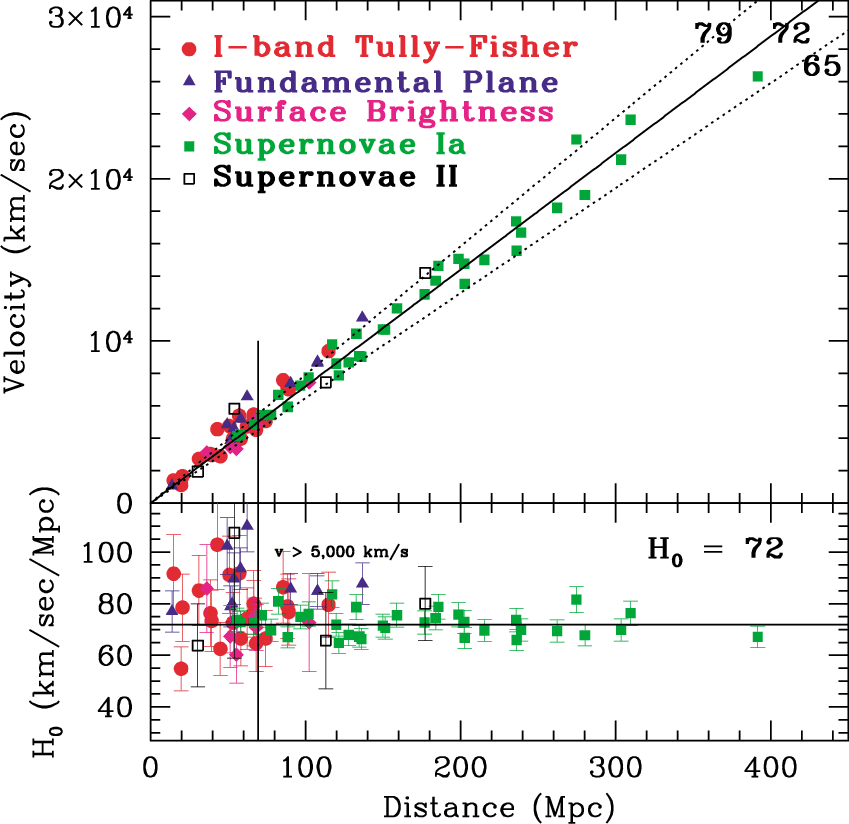
Image Credit: cfa.harvard.edu/~dfabricant/huchra/hubble/
- The significance of the Hubble Law can be explained by analogy.
- Suppose you’re on a hill and see people walking directly away from you in different directions. You detect their velocities and distances with a radar gun:
- Hiker walking north at 2 mph is 8 miles away
- Hiker walking south at 3 mph is 12 miles away
- Hiker walking east at 4 mph is 16 miles away
- Hiker walking west at 5 mph is 20 miles away
- The velocities and distances are not random but fit a pattern: the further away the walker, the faster they walk — by the same factor.
- Velocity = ¼ x Distance
- Graphing speed against miles, the hikers form a line:
- The pattern suggests that the hikers began walking at the same time and place and have been walking for four hours, each at a constant velocity
- Velocity = ¼ x Distance, implying that
- Distance / Velocity = 4
- Distance / Velocity = Elapsed Time
- Therefore, Elapsed Time = 4
- North Hiker: 8 miles / 2 mph = 4 hours
- South Hiker: 12 miles / 3 mph = 4 hours
- East Hiker: 16 miles / 4 mph = 4 hours
- West Hiker: 20 miles / 5 mph = 4 hours
- Suppose you’re on a hill and see people walking directly away from you in different directions. You detect their velocities and distances with a radar gun:
- Likewise the Hubble Law suggests that galaxies began their outward journeys at the same time and place and have been receding for 13.5894 billion years, each at its current velocity.
- Velocity = 72 x Distance, implying that
- Distance / Velocity = 1/72
- Distance / Velocity = Elapsed Time
- Therefore, Elapsed Time = 1/72
- = 1 Mpc / 72 km/s
- = 3.086 x 1019 km / 72 km/s
- = 4.28611 x1017 seconds
- = 13.5894 billion years.
- Thus a galaxy 4 Mpc away, receding at 288 km/s, and a galaxy 2,500 Mpc away, receding at 180,000 km/s, both began moving at their current velocities from the same place 13.5894 billion years ago.
- 13.5894 billion years is a simple extrapolation from Hubble’s Law.
Expansion of Space
- The Hubble Law has a problem: some galaxies are so far away that it yields velocities beyond the speed of light. For example, the galaxy GN-z11, at 9,810 Mpc, should be speeding away at 706,320 km/s, twice the speed of light, violating Einstein’s Special Relativity.
- 72 x 9,810 Mpc = 706,320 km/s
- The problem arises because Hubble used the Doppler Effect to calculate velocities from redshifts. But the Doppler Effect is not the only cause of redshifts.
- The Big Bang Theory postulates that galactic redshifts result, not from the Doppler Effect, but from the Expansion of Space
- General Relativity predicts that space expands and contracts. Gravitational waves, detected in 2015, for example, are waves of expanding and contracting space.
- More on Gravitational Waves
- General Relativity predicts that space expands and contracts. Gravitational waves, detected in 2015, for example, are waves of expanding and contracting space.
- According to the Big Bang Theory, space has expanded since the Big Bang singularity, with galaxies spreading apart yet not moving relative to each other Like raisins in rising bread dough,
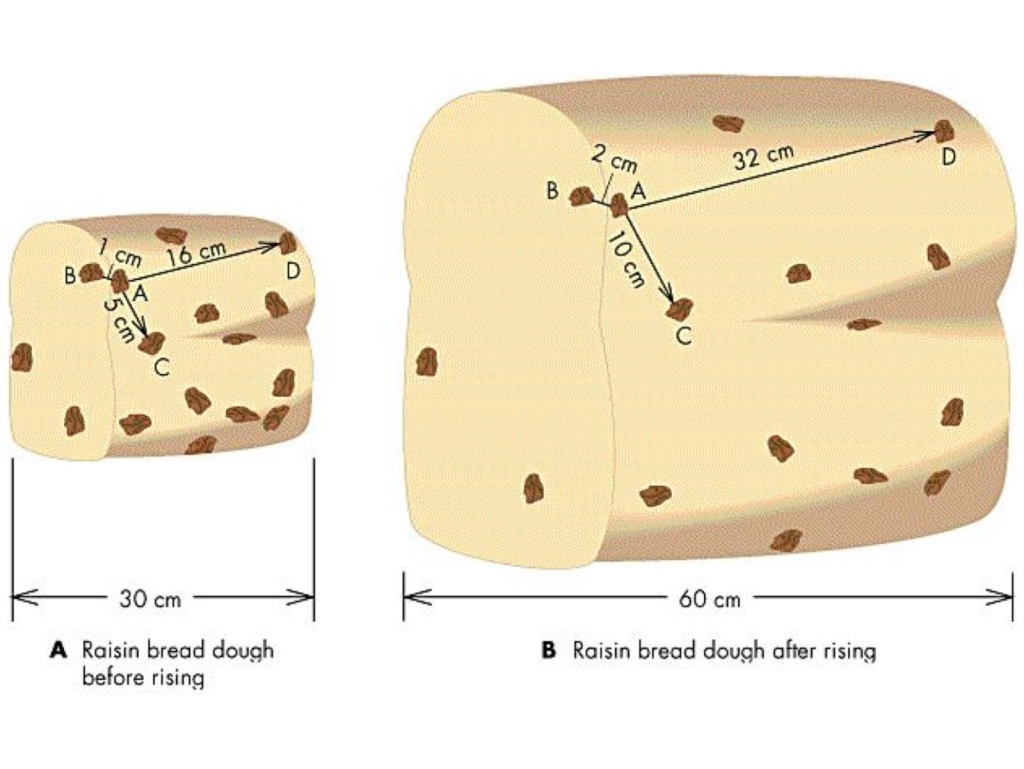
Image Credit imagine.gsfc.nasa.gov/features/yba/M31_velocity/spectrum/doppler_more.html
- Distances between raisins double without the raisins moving through the dough.
- The expansion of space explains the galactic redshift. As light travels billions of years through expanding space its wavelength increases.
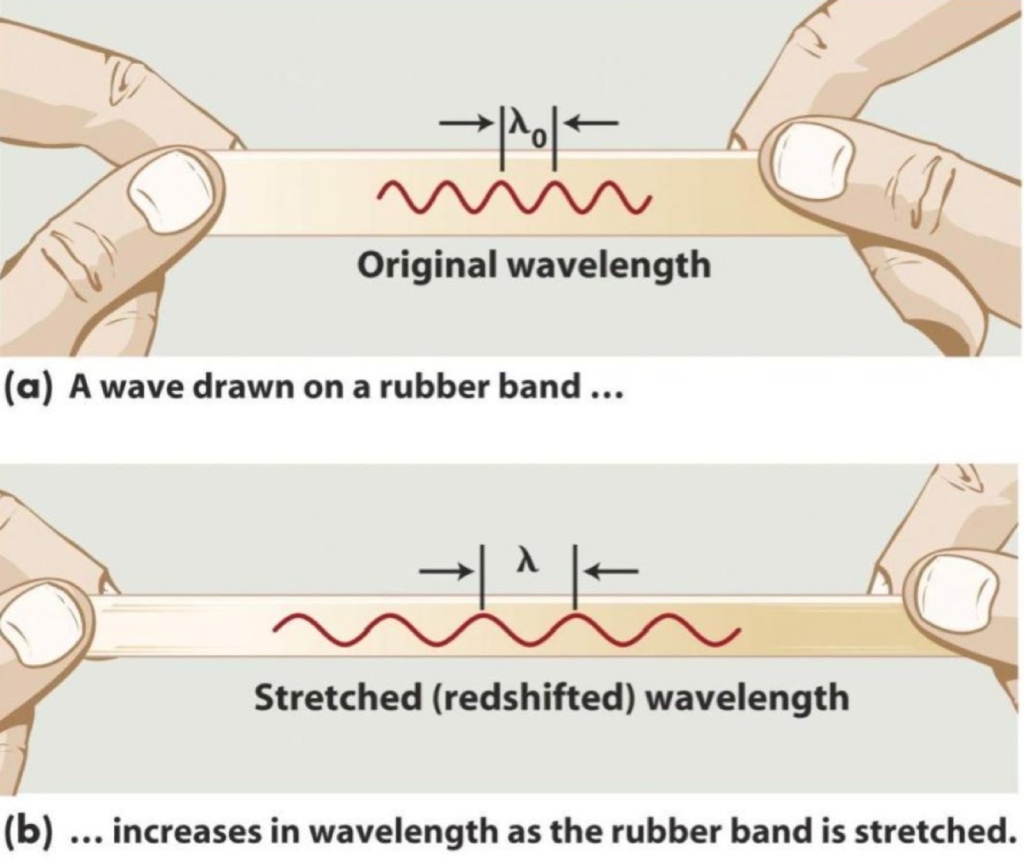
Image Credit imagine.gsfc.nasa.gov/features/yba/M31_velocity/spectrum/doppler_more.html
- The Big Bang Singularity is a point of infinite density and infinite curvature of spacetime where the laws of physics break down.
- More at Big Bang Singularity and Before.
- FAQs about the expansion of space
- If space is expanding, why is the Andromeda Galaxy heading in our direction?
- The Milky Way and Andromeda move toward each other because their gravitational attraction overcomes the expanding space between. For distant galaxies, the gravitational attraction is too small to make a difference.
- If space expands, yardsticks get longer at the same rate distant galaxies separate. Isn’t it theoretically impossible, therefore, to measure the expansion of space?
- Yardsticks don’t get longer: the forces holding the atoms and molecules of the yardstick together overcome the expanding space between them.
- If space is expanding, why is the Andromeda Galaxy heading in our direction?
- As space expands:
- The distance between atomic nuclei and electrons remains the same, since electric forces overcome the expanding space between them.
- The distance between the ends of a yardstick remains the same, since intermolecular forces overcome the expanding space within the yardstick.
- The distance between the Sun and planets remains the same, since gravitational forces overcome the expanding space among them.
- The distance between the Milky Way and the Andromeda Galaxy decreases, since their gravitational attraction overcomes the expanding space between them.
- But the distance from the Milky Way to distant galaxies increases because their gravitational attraction is too weak to overcome the expanding space between them.
Entire line expands but Sun and Earth remain the same distance apart

- Hubble, problematically, stated his law in terms of distance and velocity. The Big Bang Theory, as we’ll see, reformulates Hubble’s Law in terms of the expansion of space.
Friedmann Equation
- In 1922, seven years before the Hubble Law, Russian mathematician Alexander Friedmann introduced a remarkable equation that remains today the theoretical basis for the expansion of the universe.

Understanding the Friedmann Equation without knowing the math.
- The key to understanding the Friedmann Equation is a(t), the scale factor, an index representing the size of space at a time t.
- The equation governs how a(t) changes over time, indicating whether space is expanding or contracting, and how fast.
- For example, if a(t) equaled 1,000 a billion years ago and is 1,200 today, space has expanded 20% since then. Galaxies 50 Mpc apart then are 60 Mpc apart now.
- The equation says, in effect, that the expansion or contraction of space (the left side of the equation) depends on ρ (rho), the density of the universe, the amount and kind of stuff in an average unit volume of space.
- Stuff includes:
- Matter, consisting of
- Ordinary matter
- Dark matter
- Radiation, which includes
- Photons
- Neutrinos
- Dark Energy
- Matter, consisting of
- The equation’s other parameters:
- k is the curvature of spacetime
- k = +1, 0, -1 for closed, flat and open universes
- G is the universal gravitational constant
- c is the speed of light
- k is the curvature of spacetime
- Friedmann derived his equation from Einstein’s General Relativity and the Cosmological Principle:
- The universe looks the same on a large scale no matter where in the universe you are (homogeneity) and no matter in what direction you look (isotropy).
- Thus, just as Earth is not the center of the Solar System, and the Solar System is not the center of the Milky Way, so the Milky Way is not the center of the universe.
- Britannica: Aleksandr Aleksandrovich Friedmann
- “In 1922–24 Friedmann used Einstein’s general theory of relativity to formulate the mathematics of a dynamic (time-dependent) universe. In the Friedmann models, the average mass density is constant over all space but may change with time as the universe expands. Friedmann also calculated the time back to the moment when an expanding universe would have been a mere point, obtaining tens of billions of years.”
- “Friedmann died of typhoid in 1925 at age 37.”
Particle History
and
CMB Radiation and Light Elements
Particle History of the Early Universe
- From Steven Weinberg’s The First Three Minutes
- “The redshifts of the distant galaxies tell us that the universe is expanding, so its contents must once have been much more compressed than now. The temperature of a fluid will generally rise when the fluid is compressed, so we can also infer that the matter of the universe was much hotter in the past.”
- The early universe was extraordinarily dense and hot. How did atoms and subatomic particles behave under these conditions?
- In the late 1940s particle physicists George Gamow, Ralph Alpher, and Robert Herman tried to reconstruct the early universe using the laws of particle physics. Their idea was that, as the universe cooled and expanded, protons and neutrons would form atomic nuclei, and nuclei and electrons would form hydrogen and helium atoms.
- Examples of laws of particle physics
- A free neutron, with an average lifetime of 14 minutes 40 seconds, decays into a proton, electron, and antineutrino
- A gamma ray of sufficient energy decays into an electron and a positron
- A positron is the antimatter counterpart of the electron.
- The collision of an electron and a positron results in a short-lived atom-like particle called a positronium, which decays in 10-7 seconds into two gamma rays.
- View Elementary Particles
Overview of the Particle History, from the Britannica
- Primeval Fireball
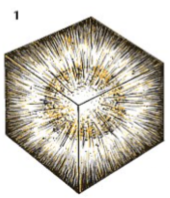
- Soup of Elementary Particles
- 1/10,000 second after Big Bang
- The universe is a condensed soup of elementary particles: quarks, leptons, antiparticles, and photons
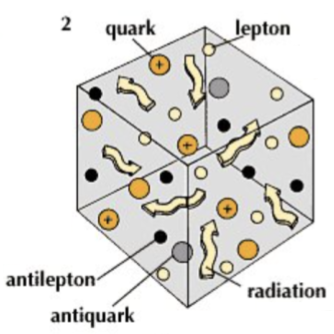
- Baryosynthesis (formation of protons and neutrons)
- 1/100 second after Big Bang
- The temperature lowers enough to enable quarks to combine to form protons and neutrons.
- A proton consists of two up quarks and a down quark.
- A neutron consists of two down quarks and an up quark.
- View Elementary Particles
- Free protons, neutrons, electrons, and photons zoom around, bouncing off one another.
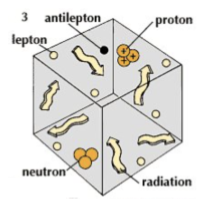
- Nucleosynthesis (formation of atomic nuclei)
- 3.5 minutes after Big Bang
- The temperature lowers enough to enable protons and neutrons to form nuclei of hydrogen and helium.
- Antiparticles have been annihilated.
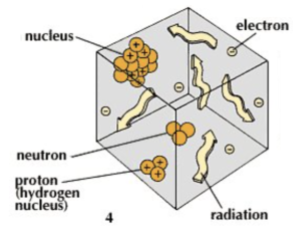
- Recombination (formation of light atoms)
- 380,000 years after the Big Bang
- The temperature lowers to 3,000 K, low enough to enable nuclei and electrons to form hydrogen and helium atoms.
- Photons now travel uninterrupted, since they no longer collide with free electrons.
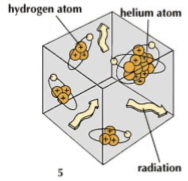
Image Credit britannica.com/science/big-bang-model/images-videos
- Three eras in the density-temperature history of the universe:
- Radiation Era
- From the Big Bang to 50,000 years after the Big Bang
- Radiation density is greater than the density of either matter or dark energy.
- Matter Era
- From 50,000 years to 10 billion years after the Big Bang
- Matter density is greater than the density of either radiation or dark energy.
- Dark Energy Era
- From 10 billion years after the Big Bang.
- Dark energy is greater than the density of either matter or radiation.
- Radiation Era
- Eras are divided into epochs.
- The closer you get to the Big Bang, the more speculative the physics becomes.
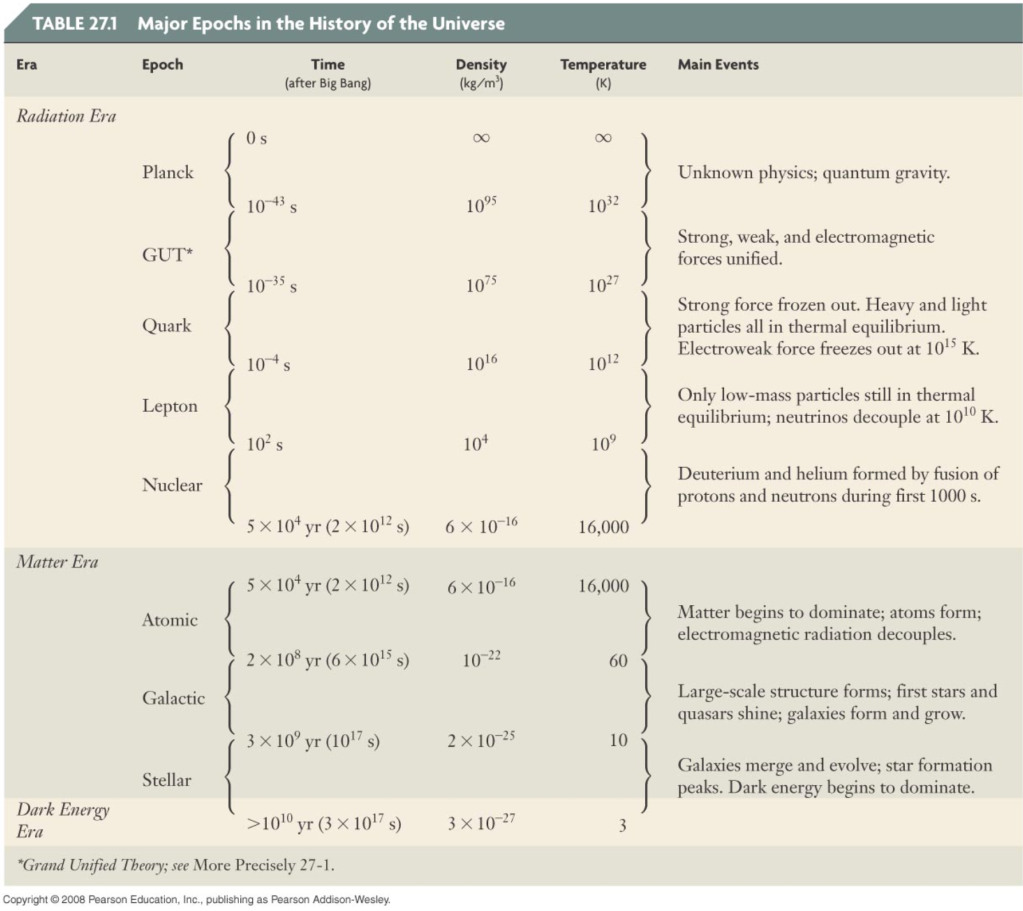
Prediction of CMB Radiation
- In 1948 Ralph Alpher and Robert Herman calculated that, due to the expansion of space, electromagnetic radiation from the early universe would today be in the microwave range, detectable by radio telescopes.
- 380,000 years after the primordial fireball, during Recombination, the temperature of the universe lowered to 3,000 Kelvin (4,940 Fahrenheit), low enough to enable nuclei and electrons to form hydrogen and helium atoms. Photons, which had been colliding with free electrons, were able to travel uninterrupted. These photons today permeate the universe. Due to the expansion of space, their wavelength increased from 0.0001 centimeters (red-infrared) to 0.19 centimeters (microwaves).
- More at Distribution of Cosmic Radiation
- Their prediction was ignored and forgotten until 1964.
Electromagnetic Spectrum
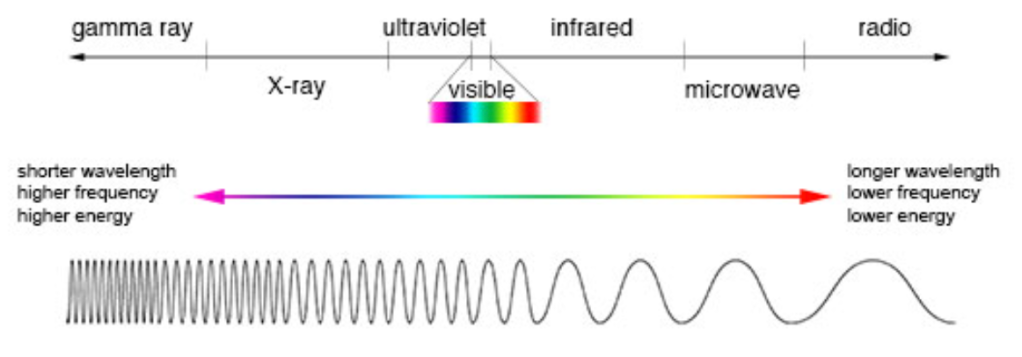
Image Credit imagine.gsfc.nasa.gov/science/toolbox/emspectrum1.html
Detection of CMB Radiation
- In 1964 Arno Penzias and Robert Wilson of Bell Labs built a horn antenna to detect radio waves from space.
- But they kept getting low-level noise in the microwave range, no matter where they pointed the antenna.
- From astronomers at MIT and Princeton they learned that the low-level noise was the Cosmic Microwave Background Radiation predicted by Alpher and Herman in 1948.
- They received the Nobel Prize in 1978
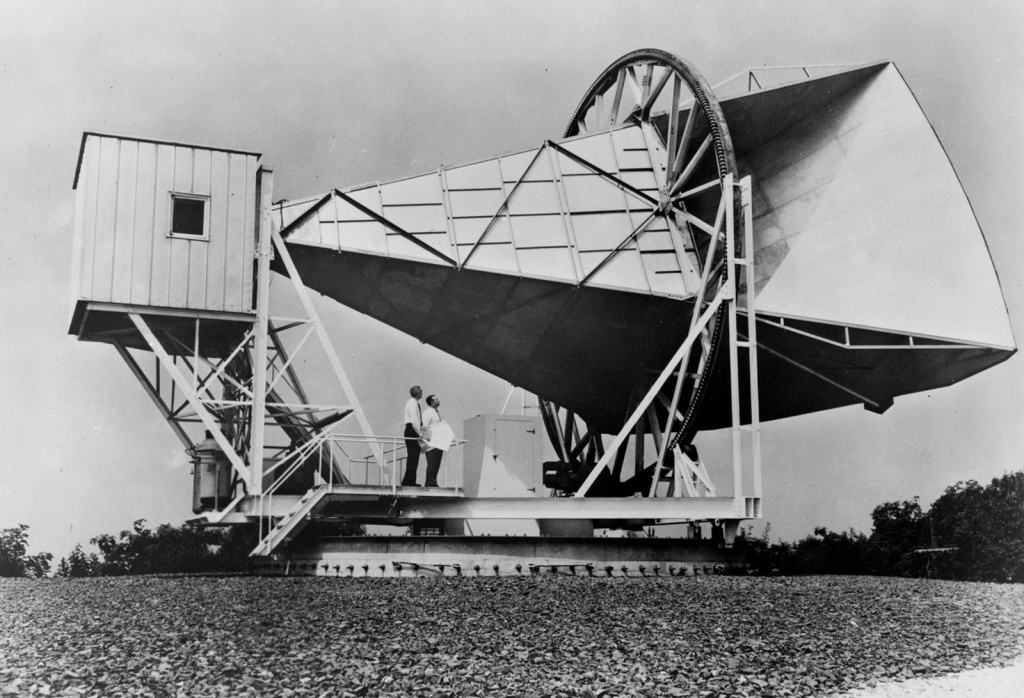
Light Elements
- The Big Bang Theory makes three predictions:
- Recession of Galaxies
- Cosmic Microwave Background Radiation
- Abundance of Light Elements
- It used to be thought that all naturally-occurring elements formed in stars. But there was a problem with helium. Helium is indeed formed in stars by nuclear fusion from hydrogen, but not enough to account for its abundance in the universe, about 25% by mass.
- The Big Bang Theory explains the abundance of helium:
- 3.5 minutes after the Big Bang, during Nucleosynthesis, protons and neutrons combined to form deuterium nuclei (1 proton + 1 neutron) and helium nuclei (2 protons + 2 neutrons), resulting in approximately 25% helium nuclei and 75% hydrogen nuclei (protons). The proportion is the same today.
Dark Matter
- In 1933 Fritz Zwicky found that the Coma cluster of galaxies did not contain enough mass in its stars to keep the cluster together gravitationally.
- In the 1970s American astronomers Vera Rubin and W. Kent Ford confirmed that the mass of the stars visible within a typical galaxy is only about 10 percent of that required to keep the stars orbiting the galaxy’s center. Most of a galaxy’s matter must be dark.
- Conjectures regarding the nature of Dark Matter:
- Hidden Baryonic (Atomic) Matter
- MACHOs (Massive Compact Halo Objects)
- Black holes, neutron stars, white dwarfs, Jupiter-sized planets, brown dwarfs
- MACHOs (Massive Compact Halo Objects)
- Non-Baryonic Matter
- Hot Dark Matter
- Neutrinos
- Cold Dark Matter
- WIMPs (Weakly interacting massive particles)
- Hot Dark Matter
- Hidden Baryonic (Atomic) Matter
Dark Energy
- In 1998 two international teams of astronomers discovered dark energy. In investigating very distant Type Ia supernovae, they discovered that billions of years ago the universe was expanding more slowly than it is today. So the universe today is expanding faster than in the past, which doesn’t make sense because the matter in the universe should be slowing the expansion.
- A supernova is a cataclysmic explosion of a star. The star brightens suddenly to many millions times it normal luminosity. Then it gradually fades over the subsequent weeks and months.
- Analogy
- Like throwing a ball straight up in the air except that, after slowing down, the ball speeds up.
- Dark Energy: No Answers but More Questions, by Adam G. Riess and Mario Livio, Scientific American, 2016 (Reiss received the Nobel Prize in 1998 for leading one of two teams that discovered dark energy.)
- Scientists have a number of hypotheses for what might be driving the acceleration of the universe.
- First Hypothesis: Empty Space, teeming with virtual particles, is inherently anti-gravitational.
- The leading candidate arises from the nature of empty space. In quantum physics a vacuum is not “nothing”—rather it is teeming with pairs of “virtual” particles and antiparticles that spontaneously appear and annihilate one another within a tiny fraction of a second. As strange as it may sound, this sea of ephemeral particle pairs carries energy, and energy, just like mass, can produce gravity. Unlike mass, however, energy can create either an attractive or a repulsive gravity, depending on whether its pressure is positive or negative. The vacuum energy in empty space, according to theory, should have a negative pressure and thus may be the source of the repulsive gravity driving the accelerated expansion of the universe.
- This idea is equivalent to the “cosmological constant,” a term Albert Einstein added to his general relativity equations that represents a constant energy density throughout space. As the name implies, this hypothesis holds that the density of dark energy is constant—that is, unvarying—over space and time. So far the astrophysical evidence we have best fits with the cosmological constant explanation, with some discrepancies
- Second Hypothesis: Dark energy is a changing anti-gravitational energy field permeating the universe called quintessence.
- Alternatively, dark energy may be an energy field dubbed “quintessence” that pervades the universe, imbuing every point in space with a property that counteracts the pull of gravity. Physicists are familiar with fields—the everyday forces of electromagnetism and gravity act via fields (although these usually arise from localized sources and do not pervade all of space).
- If dark energy is a field, it would not be a constant and so might change over time. In that case, dark energy might once have been stronger or weaker than it is now and could have affected the universe differently at different times. Likewise, its strength and impact on the evolution of the universe might alter in the future. In the so-called freezing-field version of this idea, dark energy evolves more and more slowly as time progresses; in the thawing variant, the field changes slowly at first and faster later.
- Third Hypothesis: General Relativity is incomplete.
- A third option may account for cosmic acceleration: there is no dark energy, and the quickening expansion of the universe results from physics not explained by Einstein’s theory of gravity (general relativity), which is incomplete. It is possible that in truly extreme regimes, such as the breadth of galaxy clusters or the entire observable universe, the laws of gravity work differently than the theory predicts, and gravity misbehaves. Physicists have put forth a few interesting theoretical suggestions along these lines, but no self-consistent theory that agrees with all the observations currently exists, so dark energy seems to have the upper hand over this option for now. (Previous ideas, such as the notion that cosmic acceleration is a manifestation of an uneven distribution of matter throughout the universe or the result of a network of geometric defects in the structure of space, have by now largely proved to be inconsistent with observational data.)
Age and Fate of the Universe
- Will space expand and cool forever, ending in the Big Chill? Or is there enough stuff in the universe so that gravity slows and reverses the expansion, resulting in the Big Crunch?
- How old is the universe?
- The Rescaled Omega version of the Friedmann Equation provides a framework for answering these questions.
Friedmann Equation, Rescaled Omega Version
- The Rescaled Omega version of the Friedmann Equation says in effect that:
- The rate of expansion/contraction of space is a function of:
- The Hubble Constant
- The average density and kind of stuff in the universe, in particular:
- the average density of matter
- the average density of radiation
- the average density of dark energy.
- The rate of expansion/contraction of space is a function of:
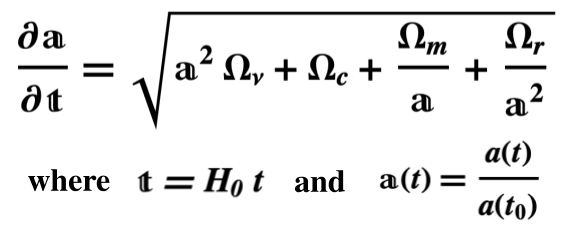
- The equation is solved for
 given values for the input variables: H0, Ωm, Ωr, Ων
given values for the input variables: H0, Ωm, Ωr, Ων  is then converted to
is then converted to  , using
, using
 is the scale factor, representing the relative size of space at a time t.
is the scale factor, representing the relative size of space at a time t.- The scale factor indicates whether the universe is expanding, contracting, or staying the same.
- Thus, if a(t) equaled 1,000 a billion years ago and is 1,200 today, space expanded 20%. Galaxies 50 Mpc apart are now 60 Mpc distant.
 is the rate of expansion or contraction over time.
is the rate of expansion or contraction over time.
- Input Variables:
- H0 is the Hubble Constant, the recessional velocity of distant galaxies divided by their distance from us. It appears inside
 , which is defined as
, which is defined as  .
. - The Density Parameters are a measure of the relative amounts of matter-energy in an average unit volume of space.
- Ωm is for ordinary and dark matter
- Ωr is for radiation, mostly photons
- Ων is for dark energy
- H0 is the Hubble Constant, the recessional velocity of distant galaxies divided by their distance from us. It appears inside
- Ωc, which equals 1 – Ωm – Ωr – Ων, represents the curvature of spacetime.
An Analogy
- A railgun is a cannon that fires a projectile using electromagnetic force rather than gunpowder. Its muzzle velocity is over twice that of a high-powered rifle.
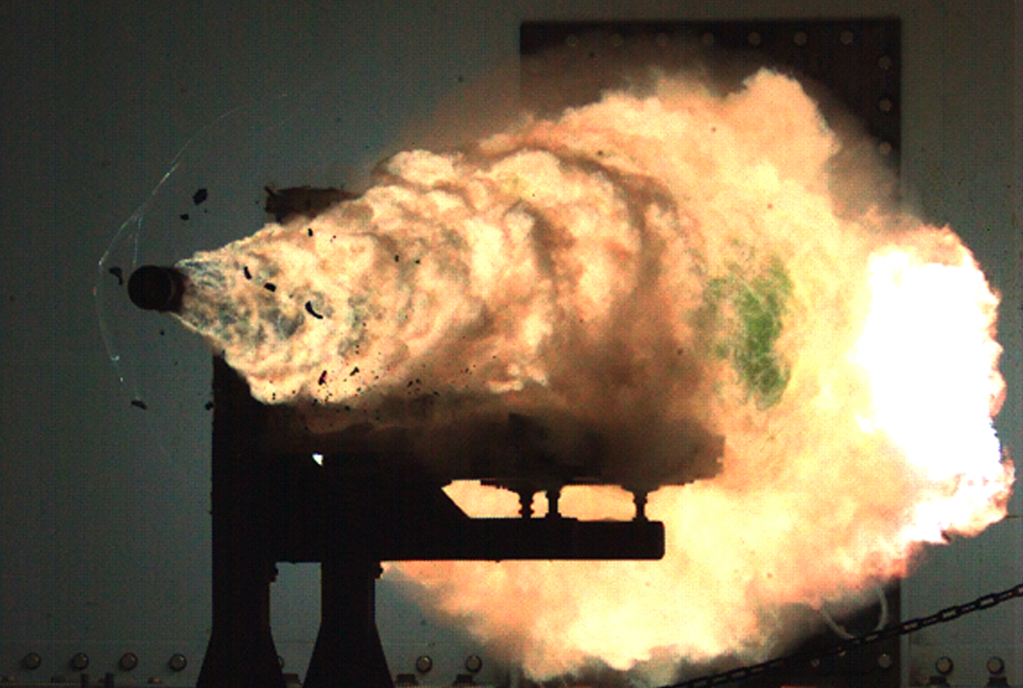
Image Credit wikipedia.org/wiki/Railgun
- Say we transport a railgun to the Moon, where it’s fired straight up into space.
- Two factors determine whether the projectile falls back to the Moon or keeps going:
- The projectile’s muzzle velocity.
- The Moon’s gravitational force.
- Analogs with the Big Bang Theory:
- The Big Bang is like the firing of the railgun.
- The expansion and contraction of space are like the projectile’s motion away from and toward the Moon.
- The density of the universe is like the Moon’s mass, exerting a gravitational pull on the projectile.
- The Hubble Constant is like the velocity of the projectile divided by its distance from the Moon.
- Ω is like the ratio of the projectile’s muzzle velocity to the Moon’s escape velocity.
Density
- Density
- Density is the quantity of something per unit volume
- Density of the Universe
- The density ρ (rho) of the universe is the average mass and energy per unit volume, usually given in units of mass per volume:
- Grams per cubic centimeter, g/cm3
- Kilograms per cubic meter, kg/m3
- ⍴ is the sum of;
- ⍴m, the average matter density, consisting of:
- Ordinary matter
- Dark matter
- ⍴r, the average radiation energy density, consisting of:
- Photons
- Neutrinos
- ⍴ν, the average dark energy density
- ⍴m, the average matter density, consisting of:
- The density ρ (rho) of the universe is the average mass and energy per unit volume, usually given in units of mass per volume:
- Critical Density
- The critical density of the universe, ρcrit, is defined as that density such that
- Any density less than or equal to it results in an open universe that expands forever
- Any density greater than it results in a closed universe that eventually stops expanding and contracts.
- The (reverse) analog of critical density in the railgun scenario is the Moon’s escape velocity:
- Any lesser velocity results in the projectile returning to the Moon.
- Any greater velocity results in the projectile traveling into space.
- The formula for critical density is derived from the Friedmann Equation:
- ρcrit = 3H02/8πG
- If H0 is 69 km/s per Mpc, the value of ρcrit is:
- 8.94 x 10-27 kg/m3
- This amounts to about 10 atoms per cubic meter.
- The critical density of the universe, ρcrit, is defined as that density such that
- Density Parameters
- Ω is the ratio of the present density of the universe to the critical density
- Ω = ρ(t0)/ρcrit
- If Ω ≤ 1, the universe is open and expands forever
- If Ω > 1, the universe is closed and eventually contracts
- Ω is the ratio of the present density of the universe to the critical density
Different Amounts of Stuff
- In the following graphs
- the horizontal axis is the age of the universe in billions of years (Gyr)
- the vertical axis is the scale factor, signifying the relative size of space.
- In the first graph, for example, the distance between remote galaxies at 30 Gyr, where a(t) = 8, is twice that between galaxies at 15 Gyr, where a(t) = 4.
- the dotted, vertical line indicates the present time.
Almost No Stuff
The expansion rate stays the same since there’s virtually no matter, radiation, or dark energy to affect it, the density being zero.
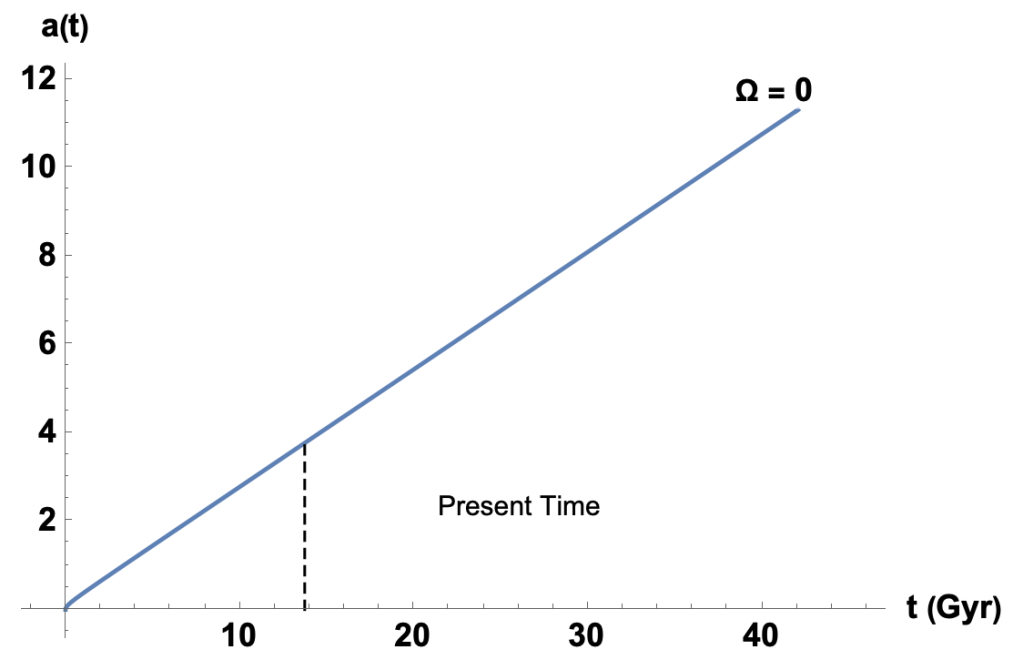
Enough Matter and Radiation to Reverse the Expansion
The density of matter and radiation is large enough to reverse the expansion, resulting in the Big Crunch around 90 billion years after the Big Bang.
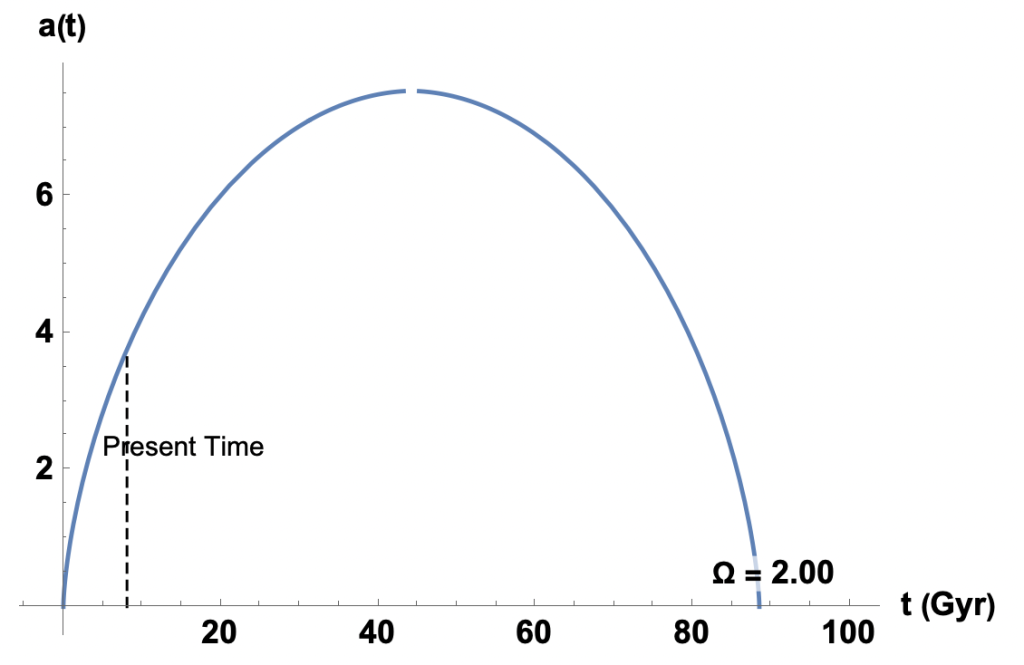
Minimal Matter and Radiation to Keep the Universe Expanding
The density of matter and radiation slows the expansion just enough to keep the universe expanding forever. Any greater density would result in the Big Crunch.
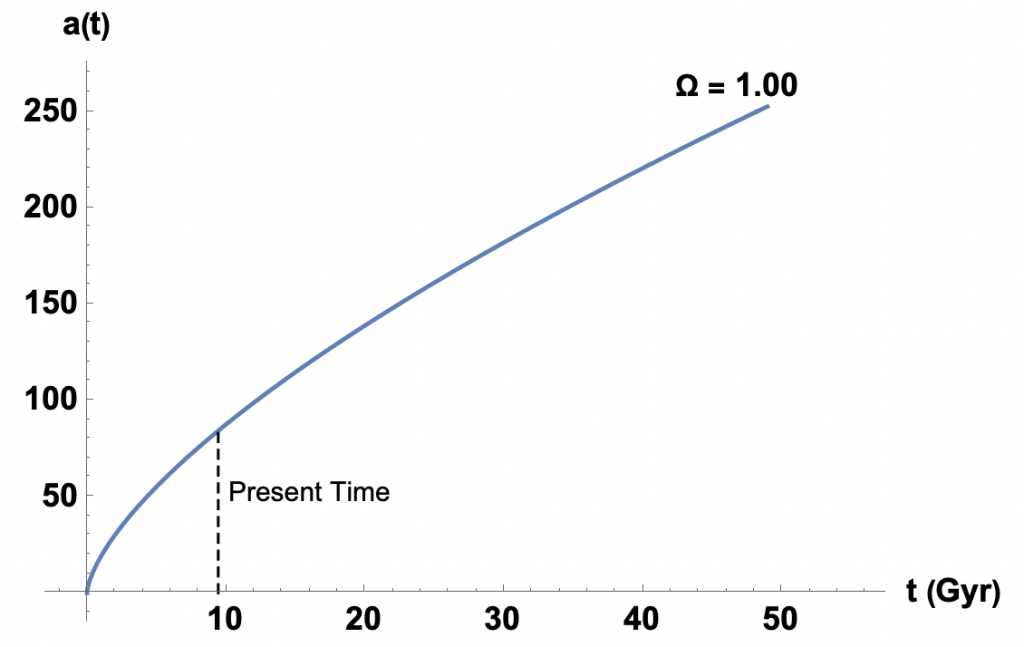
Different Kinds of Stuff
- The Density Parameters for matter, radiation, and dark energy:
- Ωm is the ratio of the matter density to the critical density
- Ωm = ρm(t0)/ρcrit
- Ωr is the ratio of the radiation density to the critical density
- Ωr = ρr(t0)/ρcrit
- Ων is the ratio of the dark energy density to the critical density
- Ων = ρν(t0)/ρcrit
- Ωm is the ratio of the matter density to the critical density
- The following graphs show the expansion of space for universes where matter, radiation, and dark energy dominate.
- The graphs show that:
- Radiation slows the expansion slightly more than matter.
- Dark energy, being repulsive, speeds up the expansion.
Matter Dominated Universe
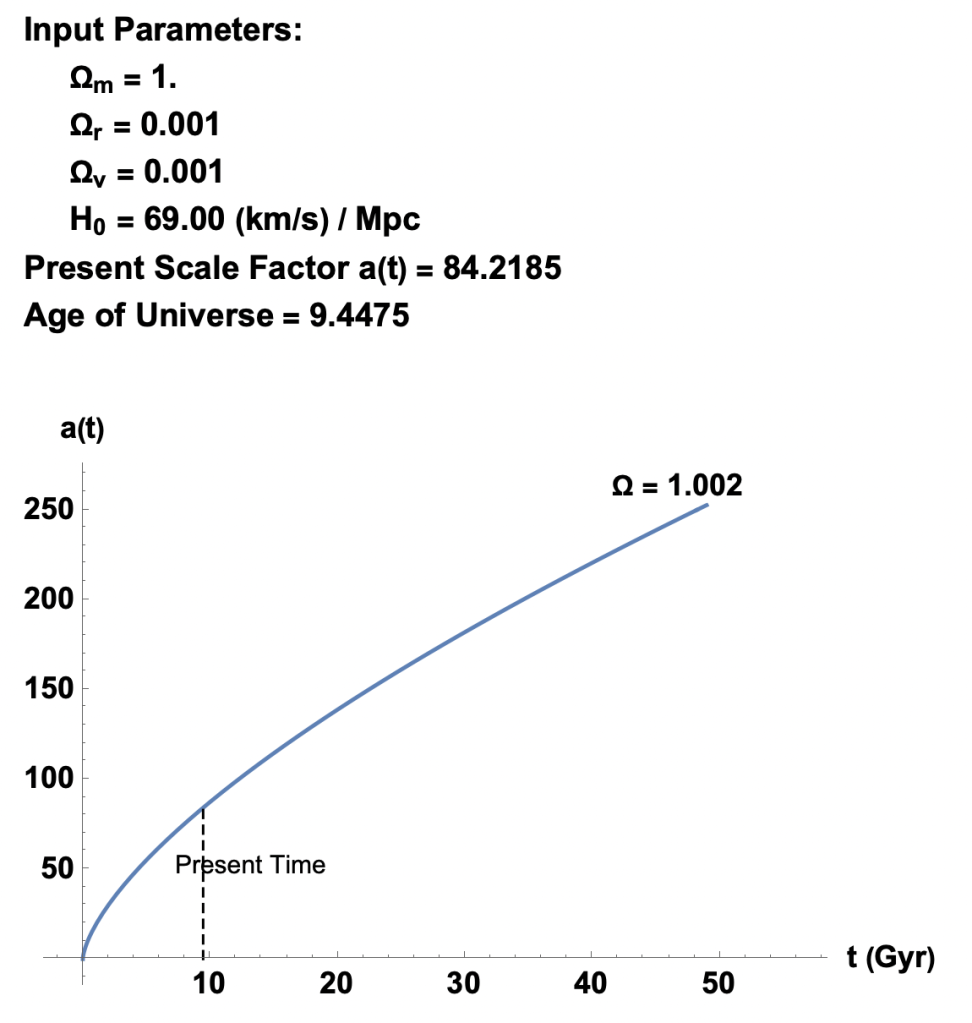
Radiation Dominated Universe
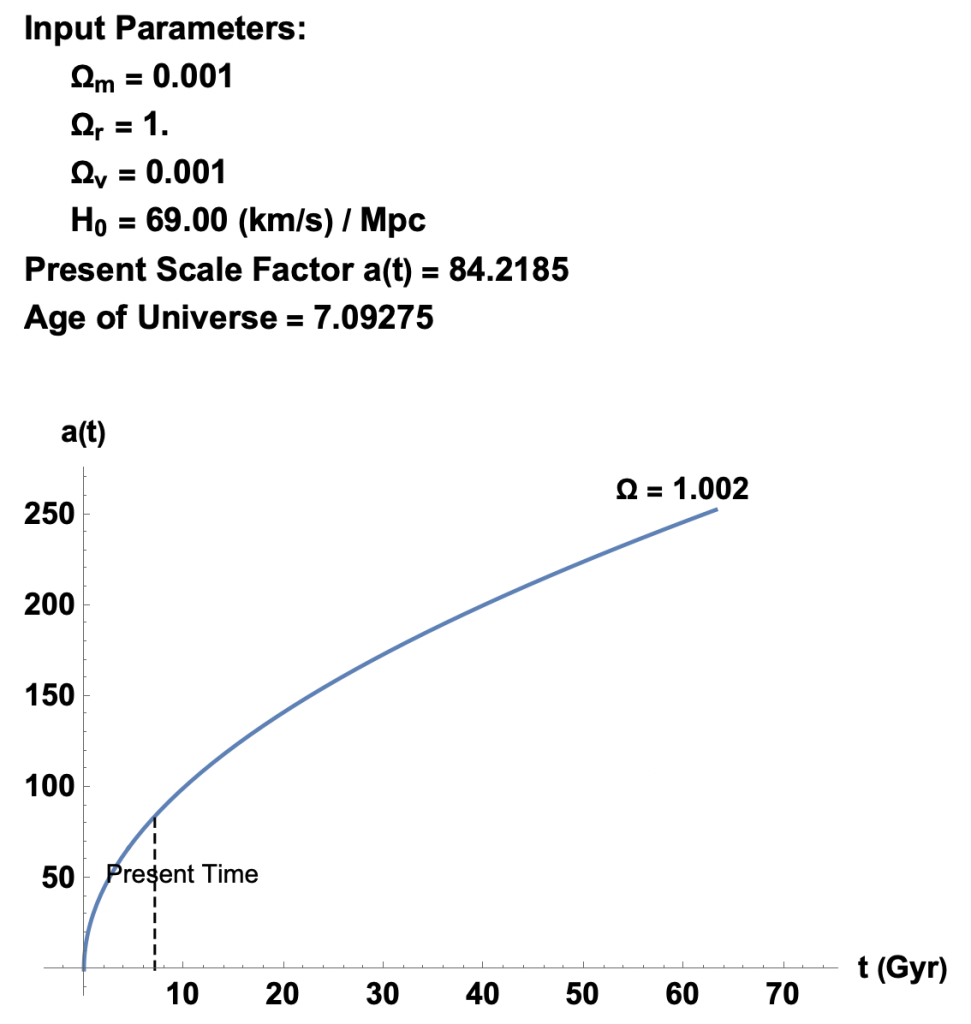
Dark Energy Dominated Universe
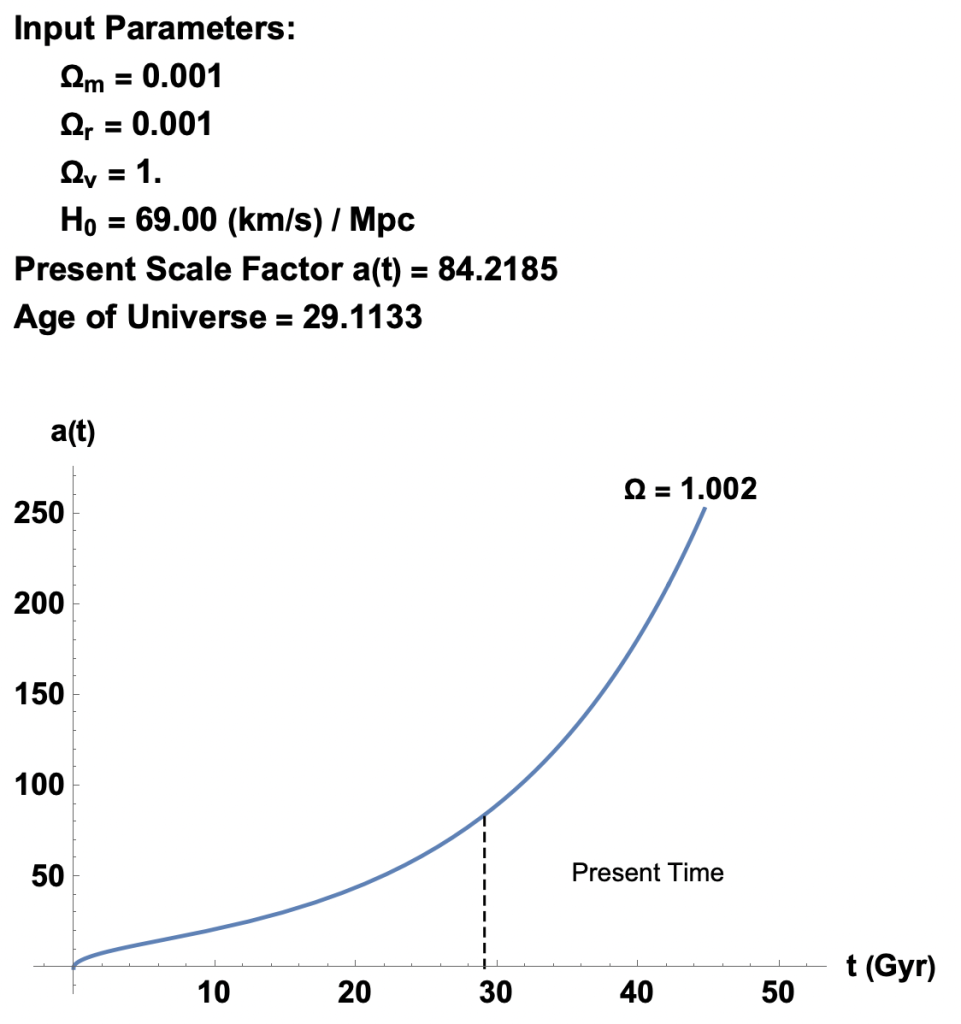
Age and Fate of the Universe, Consensus View
- The Omega version of the Friedmann Equation predicts the age and fate of the universe, based on the Hubble Constant and density parameters.
- Measurements of the Hubble Constant range from 67 to 77 km/s per Mpc.
- Measurements of the density of matter yield values of Ωm around 0.3, mostly dark matter.
- Measurements of dark energy yield values of Ων around 0.7.
- Measurements of radiation, mostly the CMB, show Ωr near zero.
- Age and fate of the universe based on a reasonable estimate of the parameters:
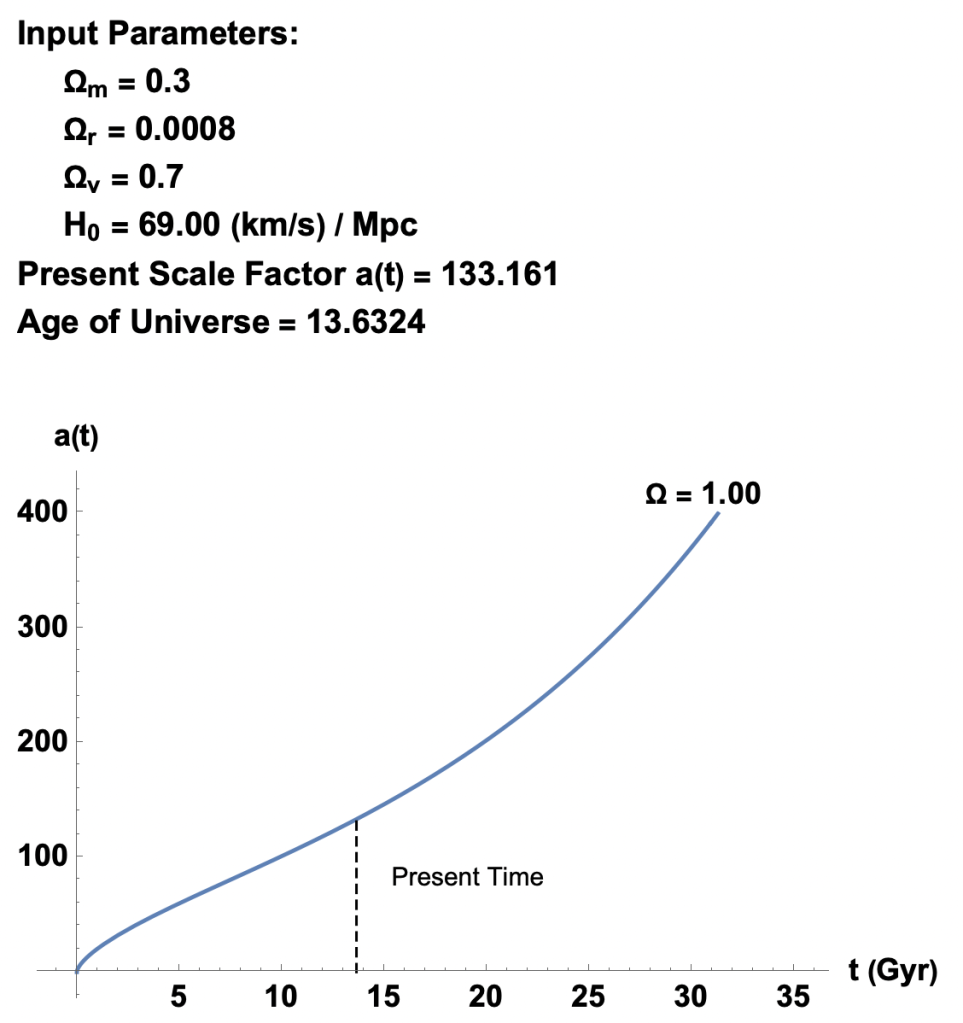
- Thus
- The universe is about 13.6 billion years old
- Space expands forever.
- The rate of the expansion is increasing, thanks to dark energy.
Matter-Energy History of the Universe
- The Friedmann Equation can be solved for past and future values of Ωr, Ωm, and Ωv, establishing periods when each was dominant:
- Radiation-dominated Era
- From the early universe to 50,000 years after the Big Bang, Ωr was greater than either Ωm or Ωv
- Matter-dominated Era
- From 50,000 to 10 billion years after the Big Bang, Ωm was greater than either Ωr or Ωv
- Dark Energy-dominated Era
- Ωv has been greater than either Ωm or Ωr, since 10 billion years after the Big Bang.
- Radiation-dominated Era
- Matter and Radiation densities decrease with time, at different rates. The former overtakes the latter at the Matter-radiation crossover point.
- Dark energy density remains the same, overtaking matter and radiation density 10 billion years after the Big Bang
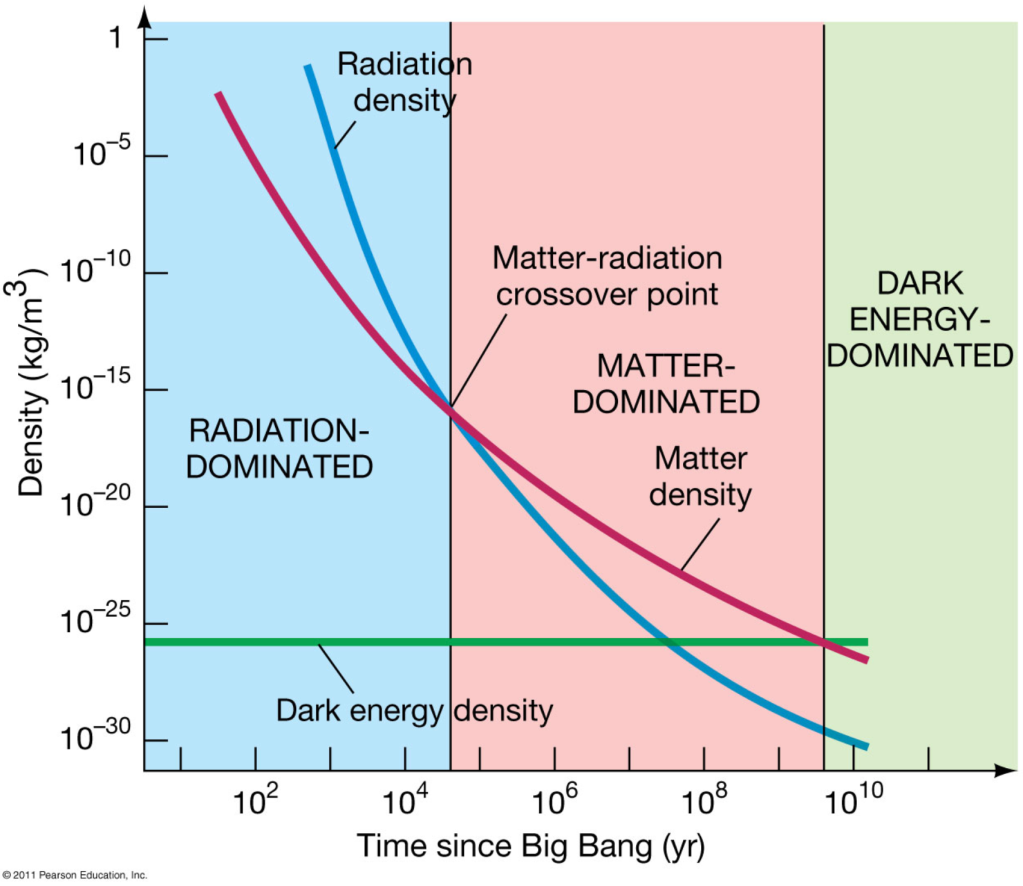
- Right Pie Chart
- Dark energy dominates today’s universe.
- Dark and atomic matter make up 30%.
- Left Pie Chart
- Dark and atomic matter dominated the 380,000 year-old universe,
- Radiation, consisting of photons and neutrinos, made up 25%.
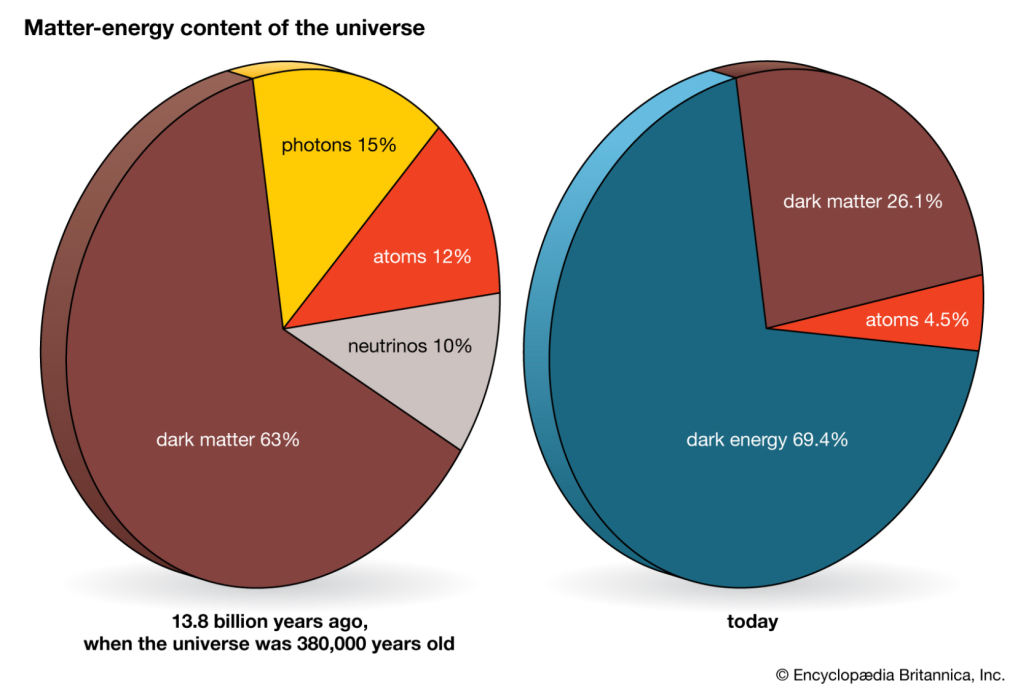
Image Credit: britannica.com/science/dark-matter
Resources
Websites
- Australia Telescope National Facility
- Britannica
- Cosmos (Swinburne University)
- Hawking Center of Theoretical Cosmology
- NASA Lambda
- NASA Universe 101
- Preposterous Universe (Sean Carroll)
- Wikipedia
Books
- First Three Minutes, Steven Weinberg
- Steven Weinberg received the Nobel Prize in Physics in 1979 for developing the electroweak theory, unifying electromagnetism with the weak nuclear force.
- Gravity: An Introduction to Einstein’s General Relativity, James Hartle
- A graduate-level textbook on General Relativity and Cosmology.
- James B. Hartle is Research Professor and Professor of Physics Emeritus at the University of California, Santa Barbara
- wikipedia.org/wiki/Hartle-Hawking_state
- In theoretical physics, the Hartle–Hawking state (named after James Hartle and Stephen Hawking) is a proposal concerning the state of the Universe prior to the Planck epoch
Addenda
Contents
- Big Bang Singularity and Before
- Calculation of Inverse Scale Factor from Omega Version of Friedmann Equation
- Distribution of Cosmic Radiation
- Existence of Galaxies
- Friedmann Equations
- Friedmann Equation, Rescaled Omega Version
- Redshift and its Causes
- Scale Factor and Hubble Concepts
- Spectrograph
Big Bang Singularity and Before
- Stephen Hawking, A Brief History of Time, page 133
- If the classical theory of general relativity was correct, the singularity theorems that Roger Penrose and I proved show that the beginning of time would have been a point of infinite density and infinite curvature of spacetime. All the known laws of science would break down at such a point.
- James Hartle, What Came Before the Big Bang, his textbook page 381
- The big bang is a singular moment of infinite density and curvature.
- Spacetime breaks down at a singularity. General Relativity has no way of determining what happened before the big bang from events after it.
- Time began at the big bang.
- Ned Wright
- The standard Big Bang model is singular at the time of the Big Bang, t = 0. This means that one cannot even define time, since spacetime is singular.
- Stephen Hawking from The Origin of the Universe
- The problem of what happens at the beginning of time is a bit like the question of what happened at the edge of the world, when people thought the world was flat. … However, when one combines General Relativity with Quantum Theory, Jim Hartle and I realized that time can behave like another direction in space under extreme conditions. This means one can get rid of the problem of time having a beginning, in a similar way in which we got rid of the edge of the world. Suppose the beginning of the universe was like the South Pole of the earth, with degrees of latitude playing the role of time. The universe would start as a point at the South Pole. As one moves north, the circles of constant latitude, representing the size of the universe, would expand. To ask what happened before the beginning of the universe would become a meaningless question, because there is nothing south of the South Pole.
- wikipedia.org/wiki/Gravitational_singularity
- A gravitational singularity, spacetime singularity or simply singularity is a location in spacetime where the density and gravitational field of a celestial body is predicted to become infinite by general relativity in a way that does not depend on the coordinate system. The quantities used to measure gravitational field strength are the scalar invariant curvatures of spacetime, which includes a measure of the density of matter. Since such quantities become infinite at the singularity point, the laws of normal spacetime break down
- wikipedia.org/wiki/Singularity_(mathematics)
- In mathematics, a singularity is in general a point at which a given mathematical object is not defined, or a point where the mathematical object ceases to be well-behaved in some particular way, such as by lacking differentiability or analyticity.
- In mathematics, a singularity is in general a point at which a given mathematical object is not defined, or a point where the mathematical object ceases to be well-behaved in some particular way, such as by lacking differentiability or analyticity.
Friedmann Equations
- First and Second Friedmann Equations
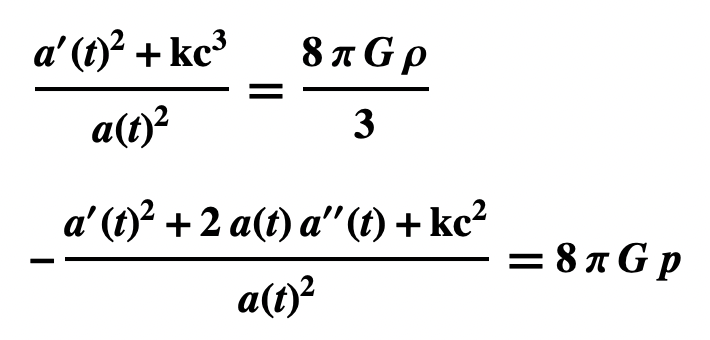
- The equations are derived from
- the Field Equation of Einstein’s General Relativity
- the Robertson-Walker Metric:

- The Second Friedmann Equation can also be derived from:
- the First Friedmann Equation
- First law of Thermodynamics for homogenous, isotropic universes , where

- where
- ρ is the density of the universe
- p is the pressure exerted by matter
Friedmann Equation, Rescaled Omega Version
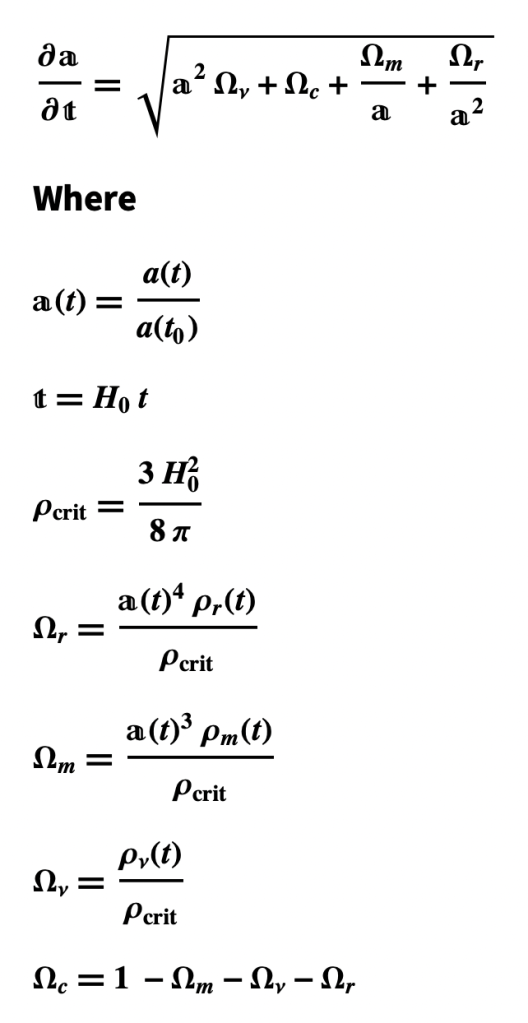
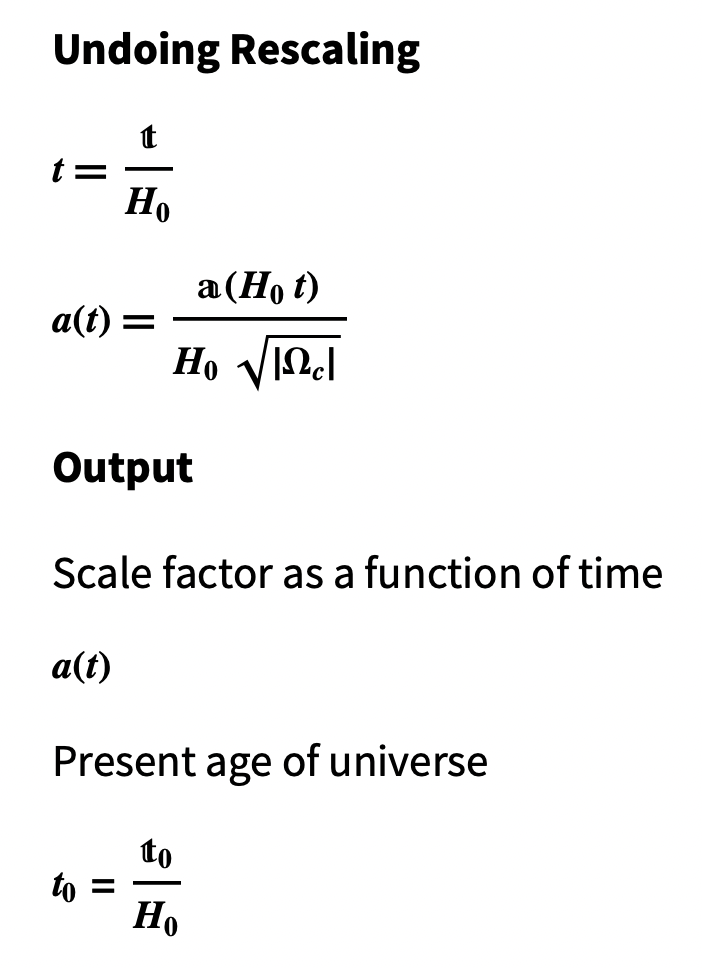
Calculation of Inverse Scale Factor from Omega Version of Friedmann Equation
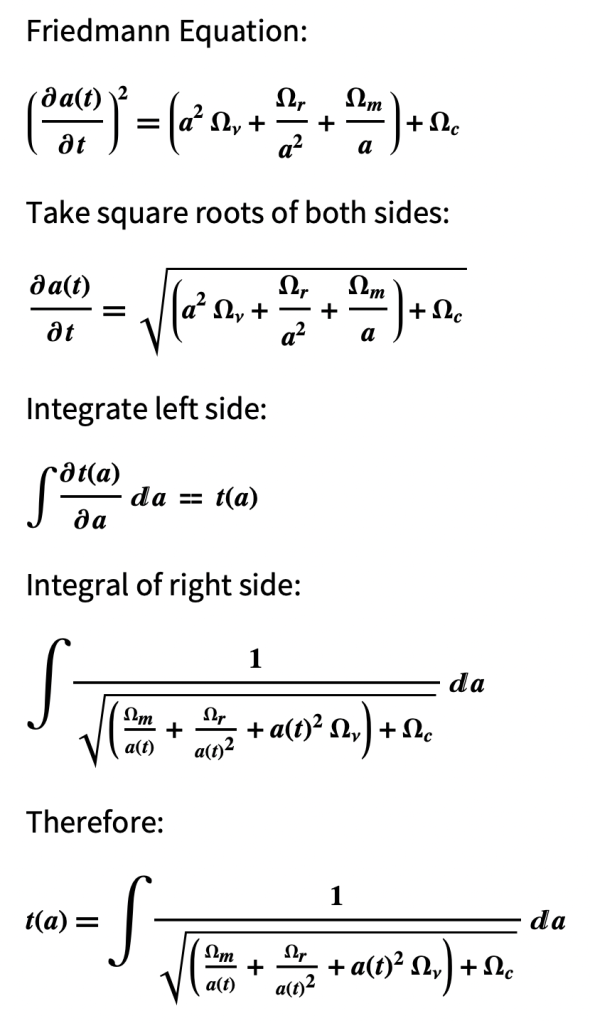
Distribution of Cosmic Radiation
- A system in thermal equilibrium at a given temperature emits a pattern of electromagnetic radiation equivalent to that emitted by a black body at that temperature.
- 380,000 years after the primordial fireball, the universe was in thermal equilibrium at 3,000 degrees Kelvin.
- Therefore, 380,000 years after the primordial fireball, the universe emitted a pattern of electromagnetic radiation equivalent to that emitted by a black body at that 3,000 degrees of Kelvin.
- The typical wavelength of a black body at 3,000 K is 1000 nanometers, in the red-infrared range.
- 1000 nanometers = 0.0001 centimeters
Distribution of Cosmic Radiation at 3,000 degrees Kelvin
Typical wavelength is 1000 nanometers = 0.0001 centimeters
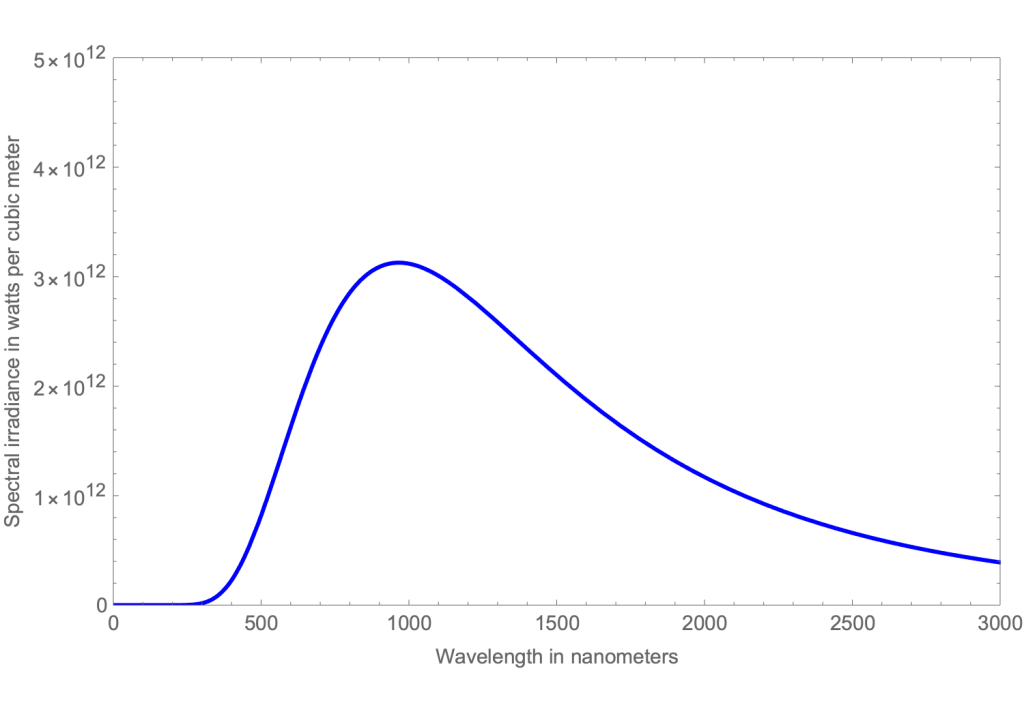
- Due to 13.8 billion years of expanding space, the typical wavelength of cosmic radiation increased from 0.0001 centimeters (red-infrared) to its current value of 0.19 centimeters (microwaves).
Distribution of Cosmic Radiation at 2.7245 degrees Kelvin
Typical wavelength is 1.9 millimeter = 0.19 centimeters
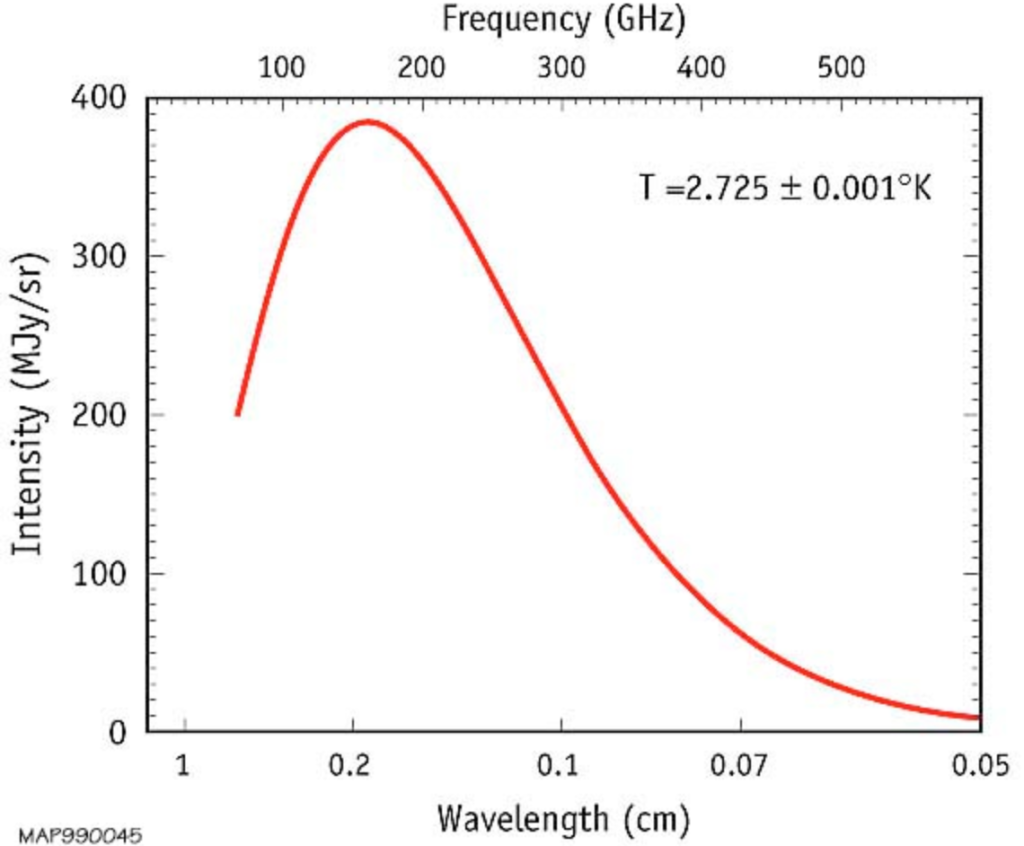
Image Credit wmap.gsfc.nasa.gov/universe/bb_tests_cmb.html
Redshift and its Causes
- Redshift is the fractional increase in wavelength from emission to reception (observation).
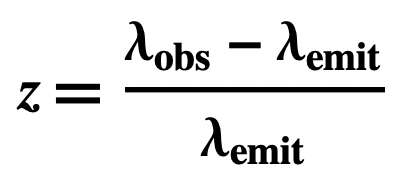
- Equivalent expressions for 𝒛:
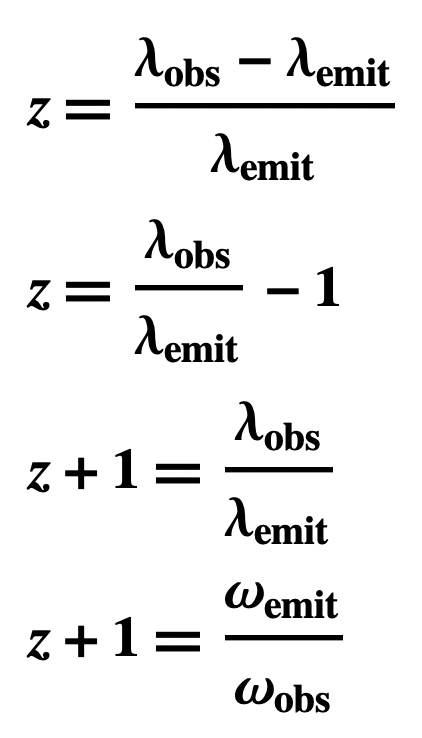
- A negative redshift is a blueshift. Thus, light from the Andromeda Galaxy, which is heading for us, has a redshift of z = −0.001001.
- Causes of Redshift
- Doppler Redshift
- Light is redshifted as it travels from a source moving away from an observer.
- If velocity v is small compared to the speed of light c:
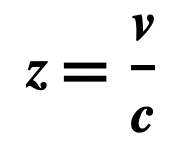
- Otherwise:
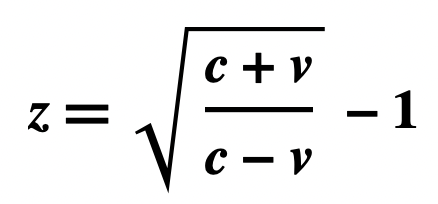
- Cosmological Redshift
- The cosmological redshift is due to the expansion of space as a wave travels from source to observer.

- Gravitational Redshift
- Light traveling from a stronger gravitational field to a weaker one is redshifted because time runs faster as the wave travels. Therefore, the wave’s period decreases, its frequency increases, and its wavelength decreases.
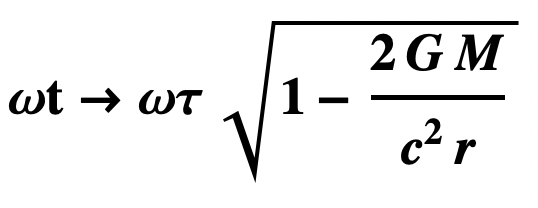
- More on Gravitational Redshift.
- Doppler Redshift
Scale Factor and Hubble Concepts
- The scale factor, a(t), is an index representing the size of space at a time t
- Scale Factor Principle

- where d0 = d(t0)
- and t0 is the present time
- That is, the distance between two points at a time t equals the distance today multiplied by the scale factor at time t
- a(t0) = 1
- Proof:
- Applying the Scale Factor Principle to present time t0 yields:
- d(t0) = a(t0) d(t0)
- From which it follows that:
- a(t0) = d(t0) / d(t0) = 1
- Applying the Scale Factor Principle to present time t0 yields:
- Proof:
- Example:
- If d0 = 100 meters and a(1 billion years ago) = 0.5, d(1 billion years ago) = 50 meters.
- Hubble Constant
- Hubble formulated the Hubble Constant in terms of velocity and distance: 72 km/s per megaparsec.
- The Big Bang Theory redefines the Hubble Constant in terms of the scale factor:
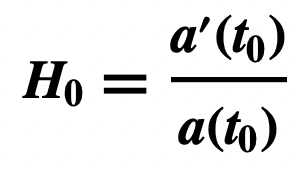
- That is, the Hubble Constant equals the current rate of change of the scale factor divided by today’s scale factor.
- The redefinition is based on the cosmological redshift
- Hubble Parameter
- The Hubble Parameter generalizes the Hubble Constant, applying to every time t rather than just the present moment t0.
- The Hubble Parameter varies over time.
- The Hubble Parameter generalizes the Hubble Constant, applying to every time t rather than just the present moment t0.
- Hubble Law
- Hubble stated his law in terms of velocity and distance:
- v = H0 x D
- The problem with his formulation is that some galaxies are so far away that their velocity would be faster than light.
- The Big Bang Theory reformulates the law in terms of distance and the scale factor.

- That is, the rate of change of distance equals the Hubble Parameter times distance.
- The reformulated Hubble Law follows from the Scale Factor Principle and the definition of the Hubble Parameter, derived below.
- Hubble stated his law in terms of velocity and distance:
- Hubble Time
- The Hubble Time is the inverse of Hubble’s Constant.
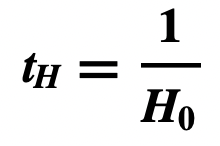
- The dimension of tH is time, since the dimension of H0 is velocity / distance, meaning that the dimension of tH is distance / velocity = time.
- tH = (1 Mpc / 72 km/s) = (3.086 x 1019 km / 72 km/s) = (4.28611 x1017 seconds) = (13.5894 billion years).
- The Hubble Time in the Big Bang Theory is today’s scale factor divided by its rate of change.
- The Hubble Time is not the exact age of the universe, since the scale factor changes over time.
- The Hubble Time is the inverse of Hubble’s Constant.
- Derivation of the Hubble Law from Scale Factor Principle and Hubble Parameter

- Scale Factor Principle

- Differentiating both sides of #1 with respect t
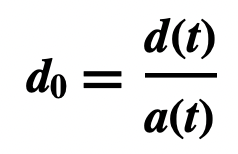
- From #1
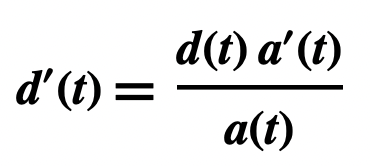
- From #2 and #3
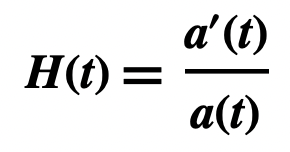
- Hubble Parameter

- From #4 and #5
Existence of Galaxies
- Before the 1920s astronomers disagreed about the nature of spiral nebulae: were they nearby stars or faraway galaxies?
- In 1923 Edwin Hubble settled the matter, establishing that the spiral nebula Andromeda was much further away than the stars.
- The Andromeda Galaxy is 2,480,000 light-years away; the star Alpheratz, for example, only 97 light-years.
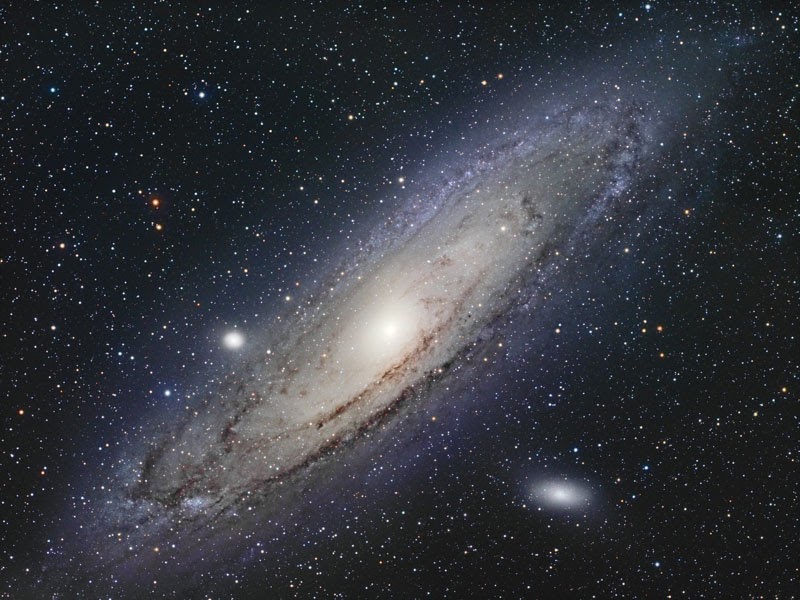
Andromeda Galaxy
Spectrograph
A spectrograph splits light into its component wavelengths.


